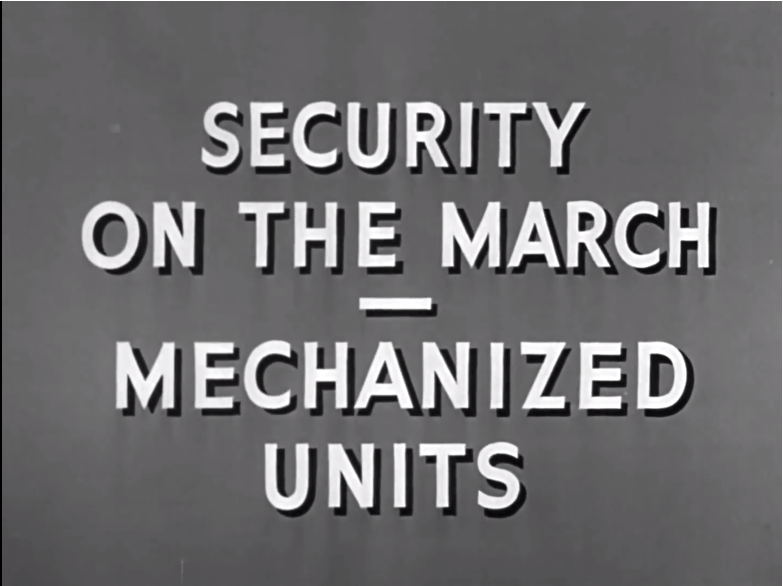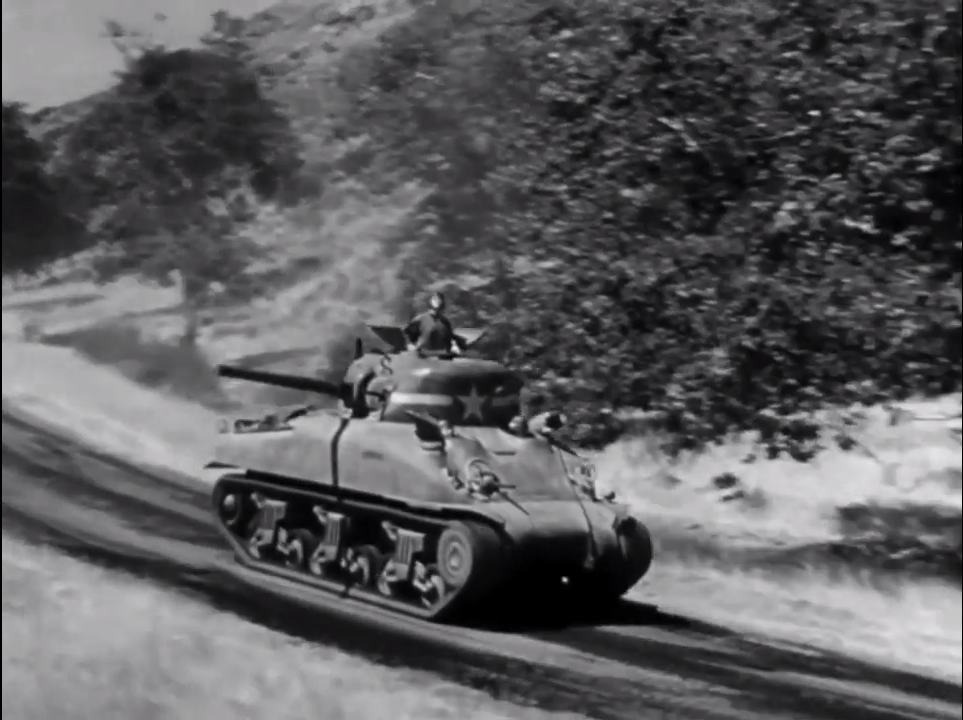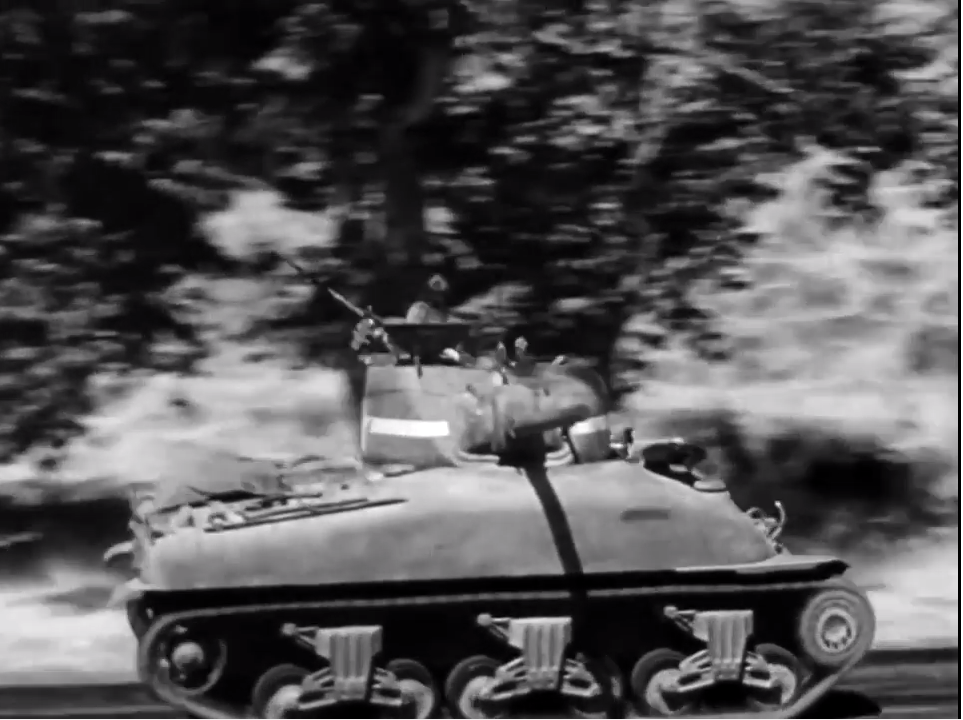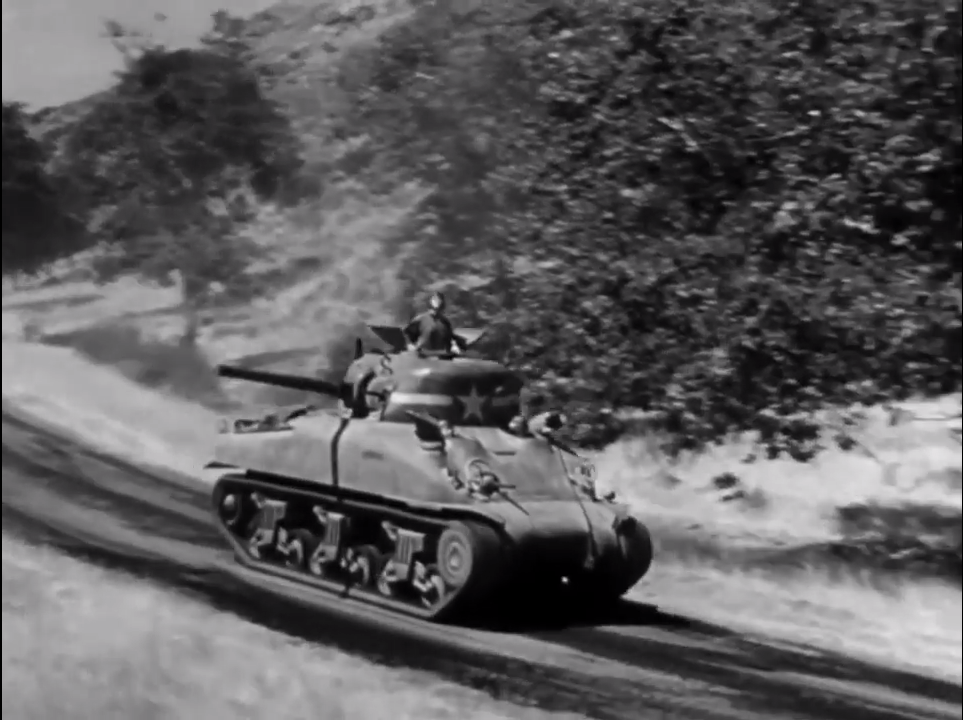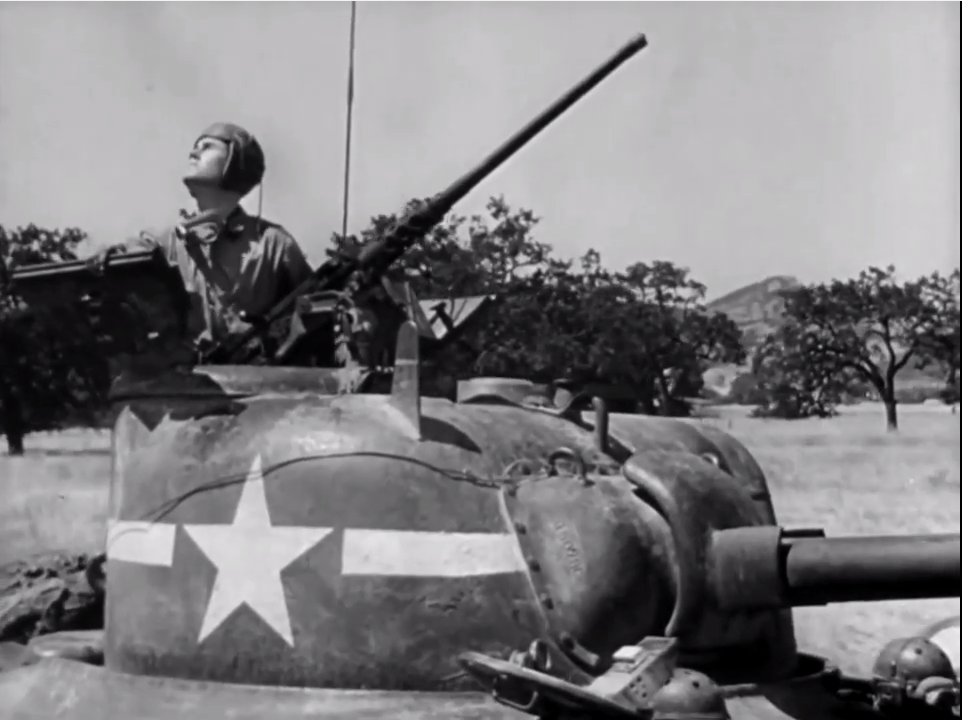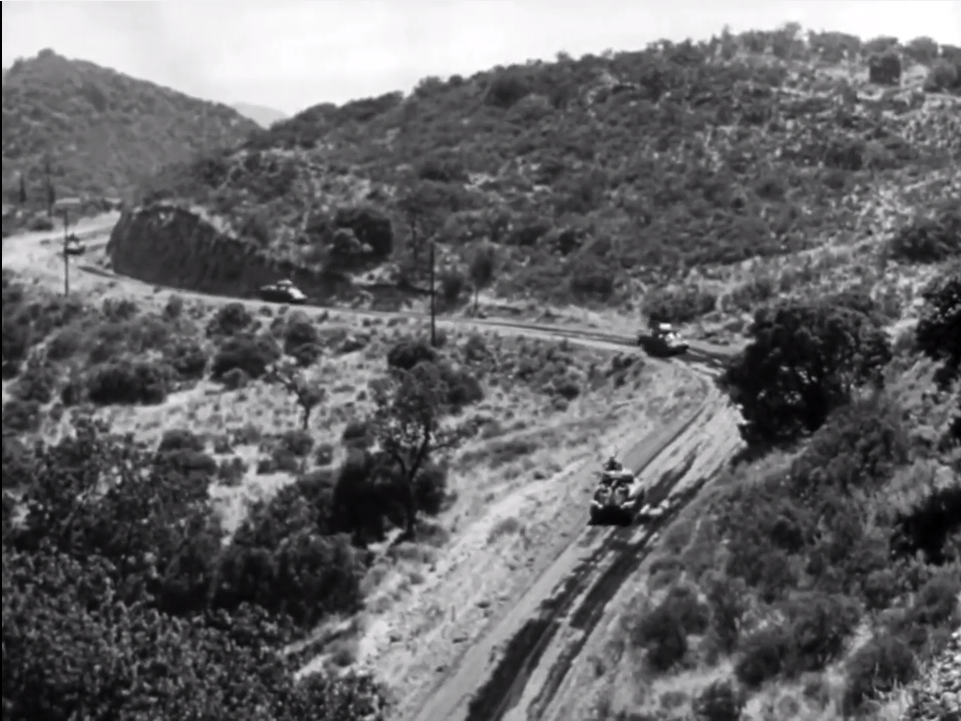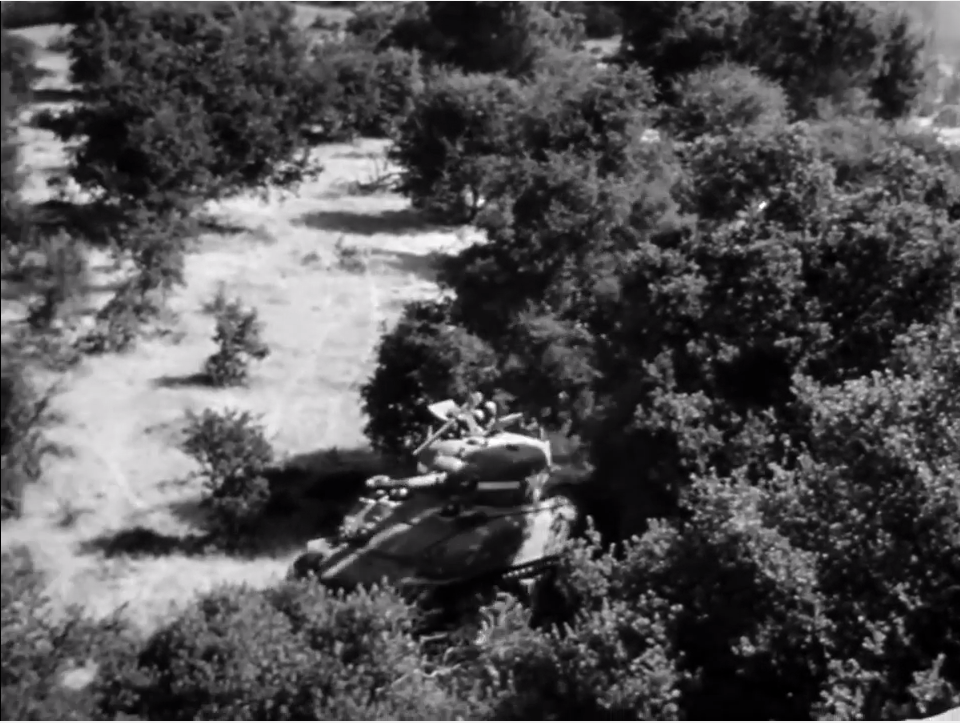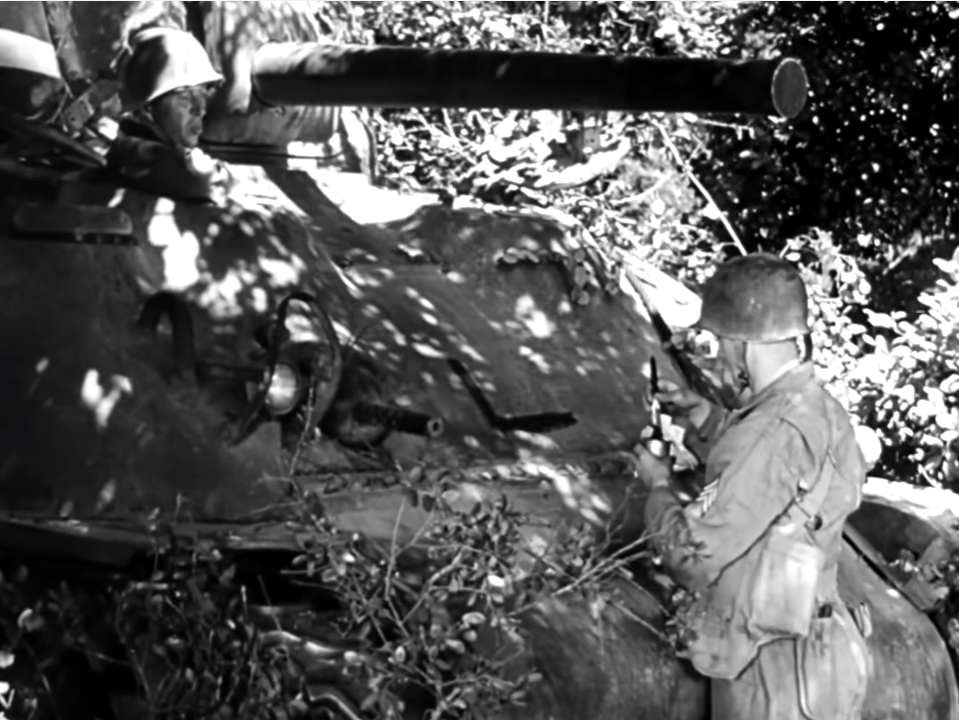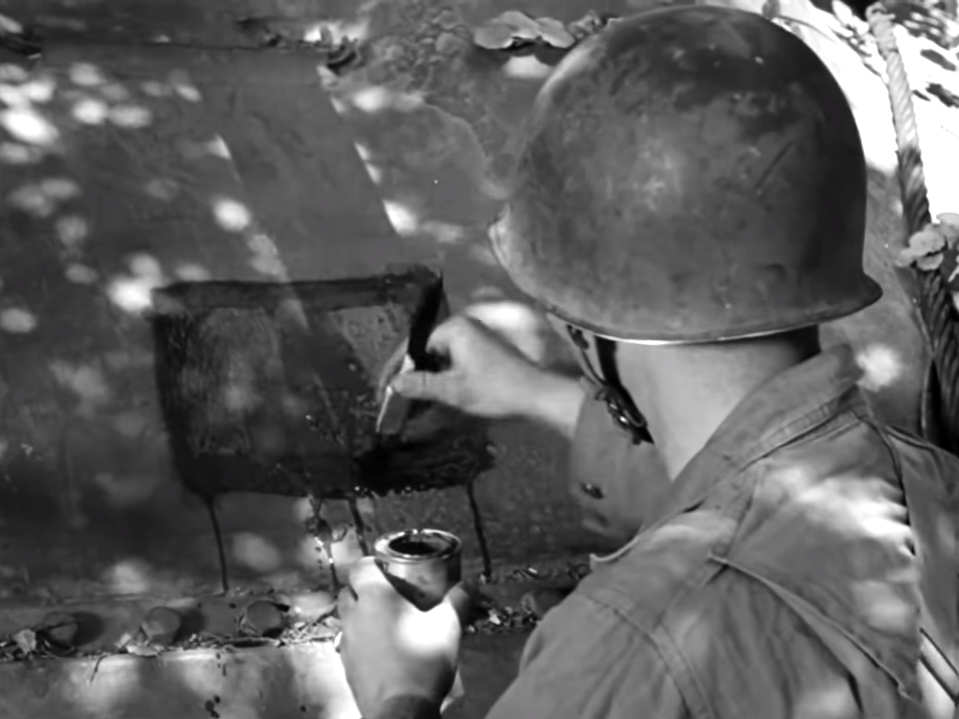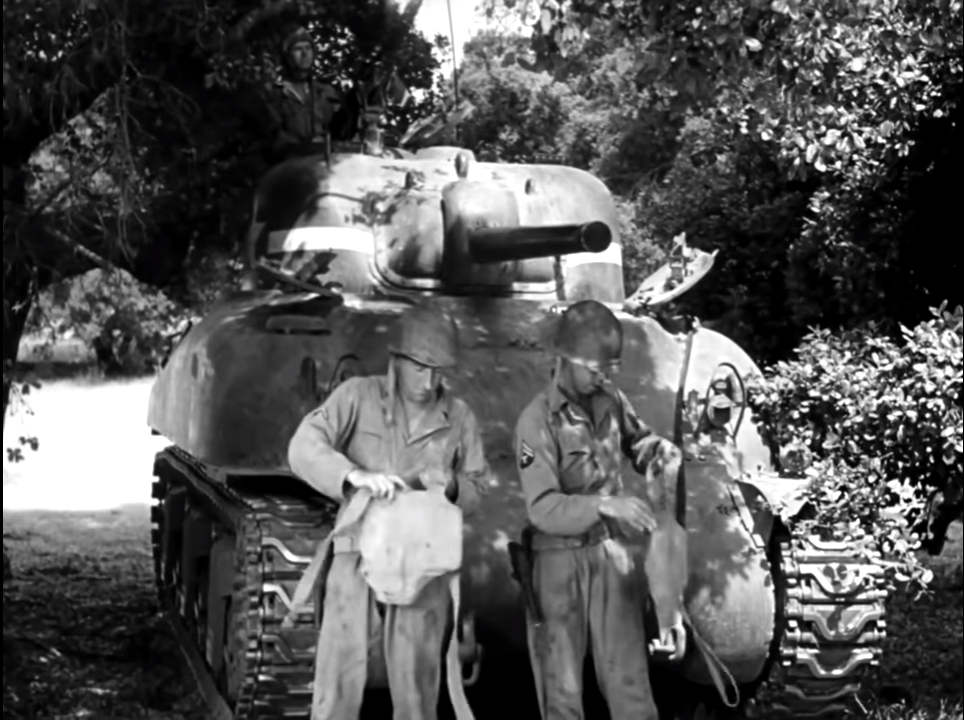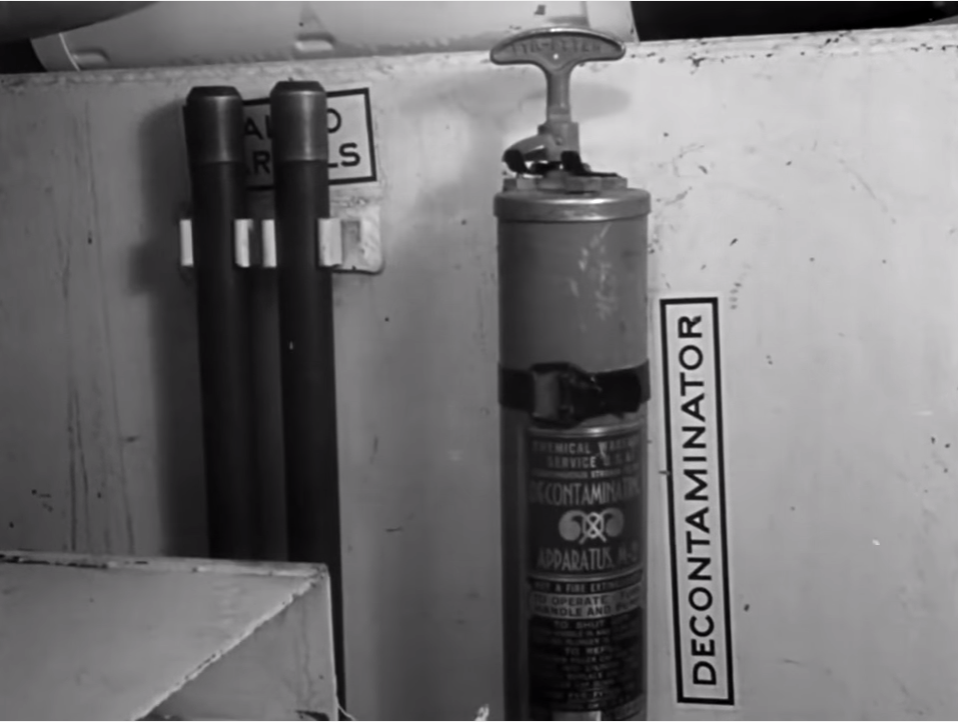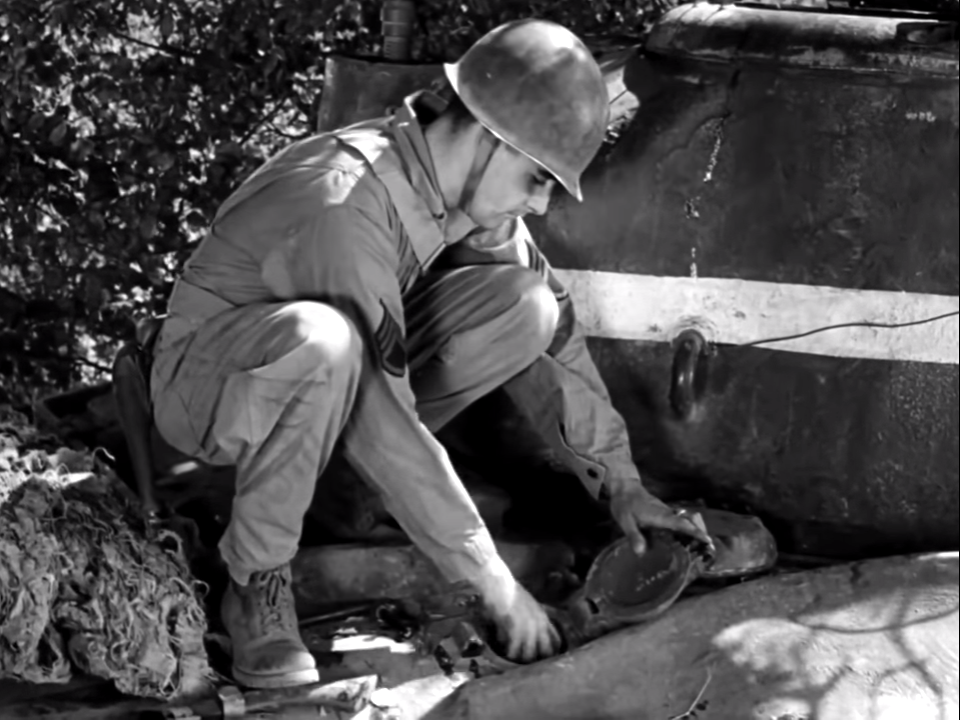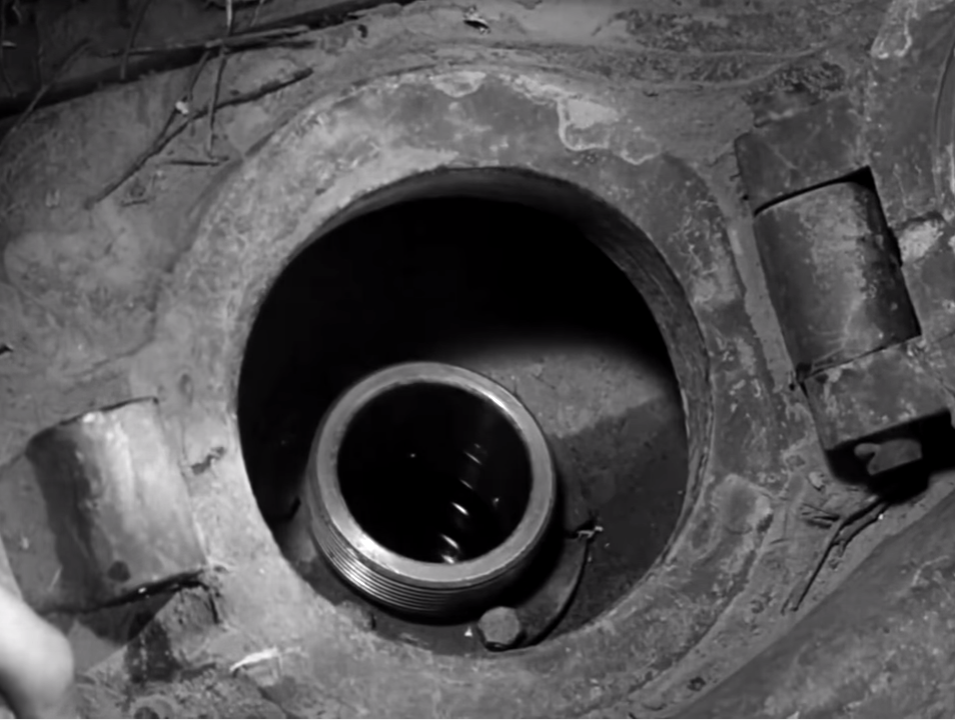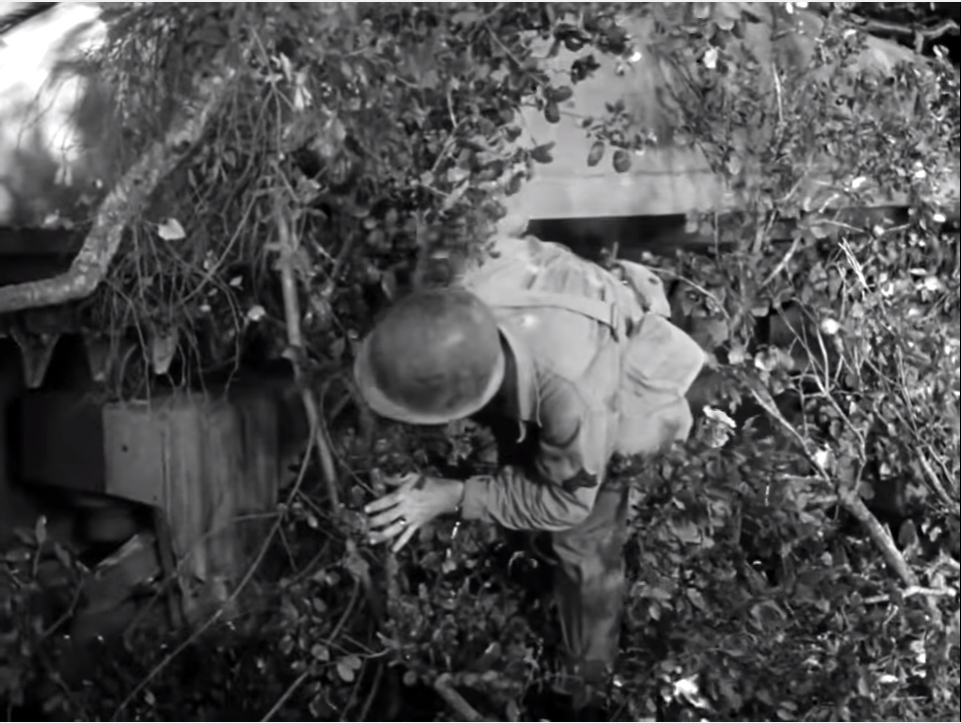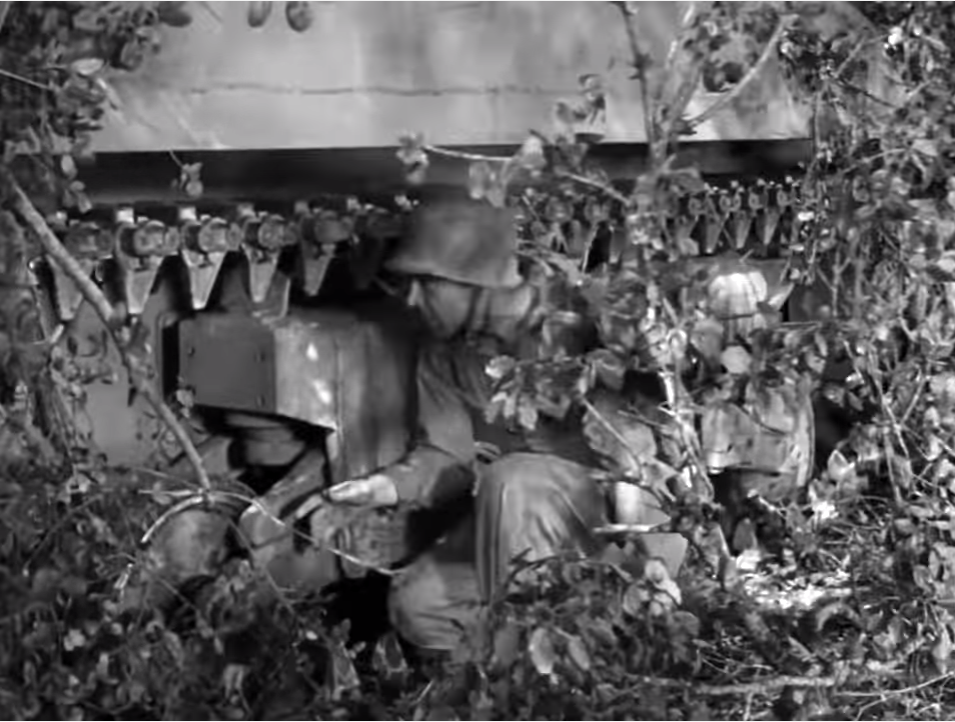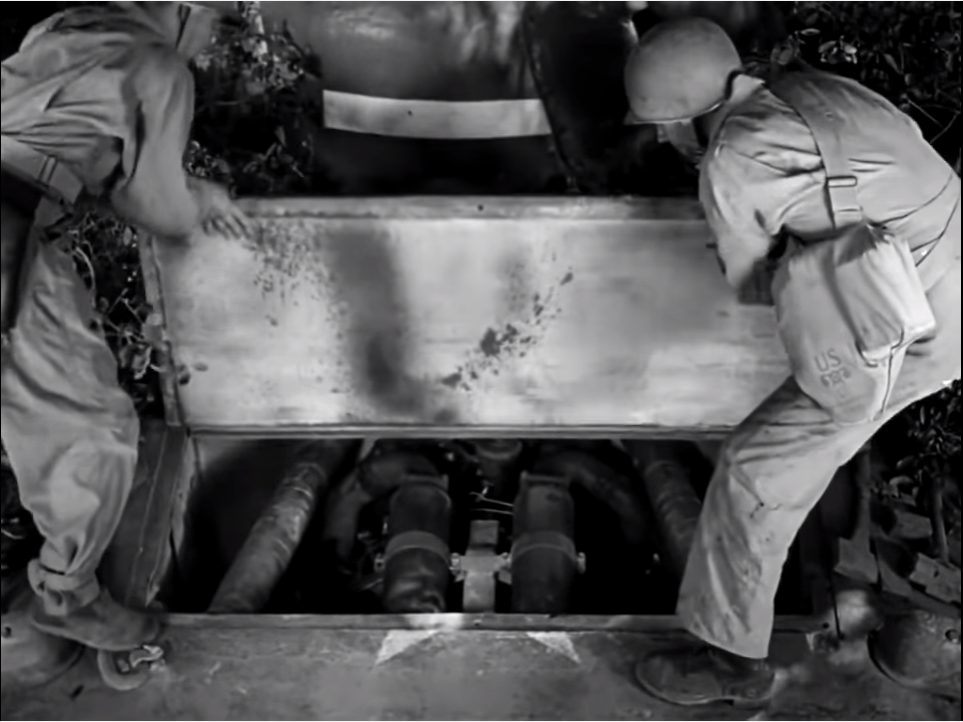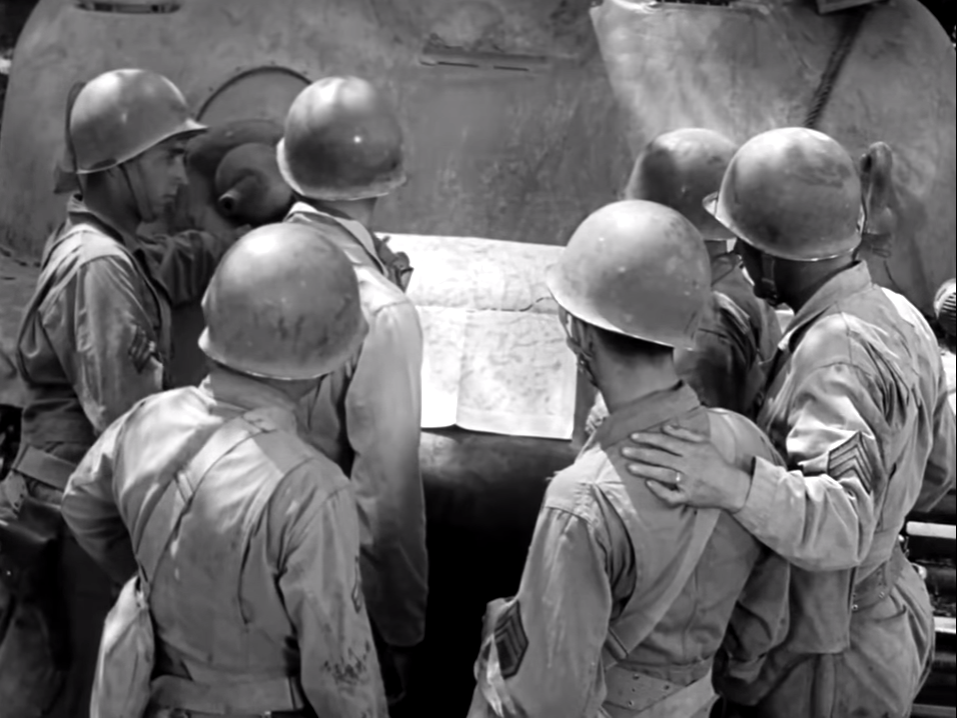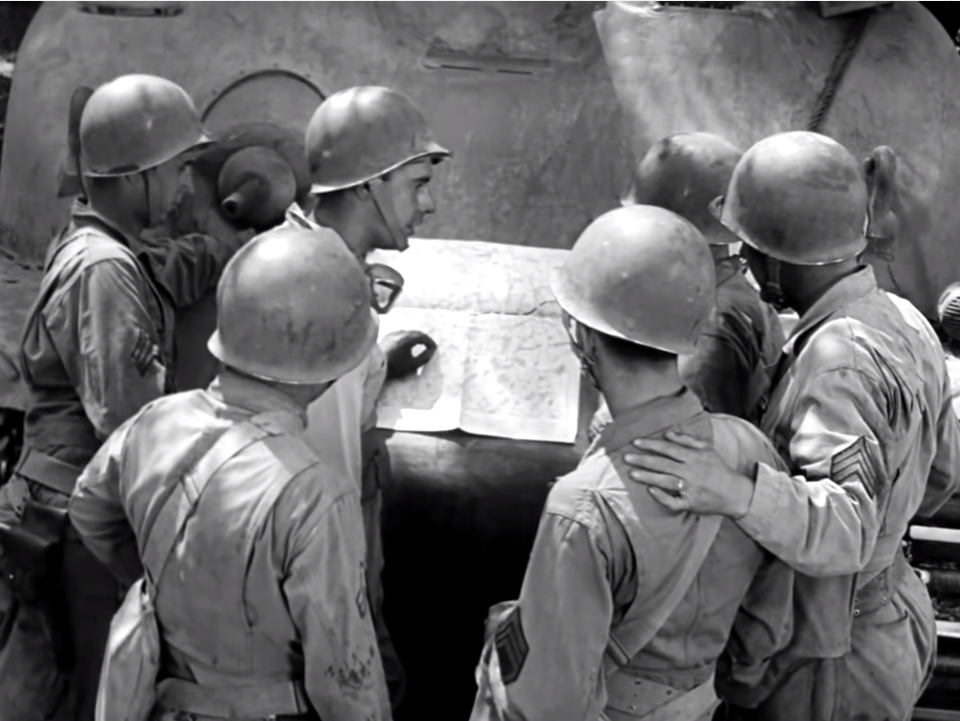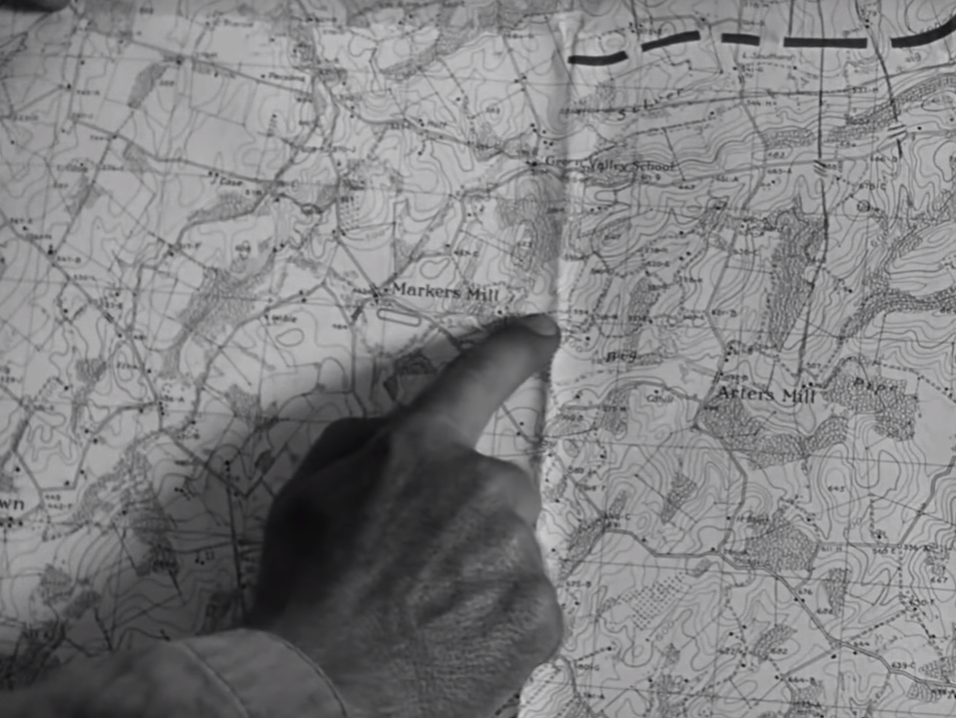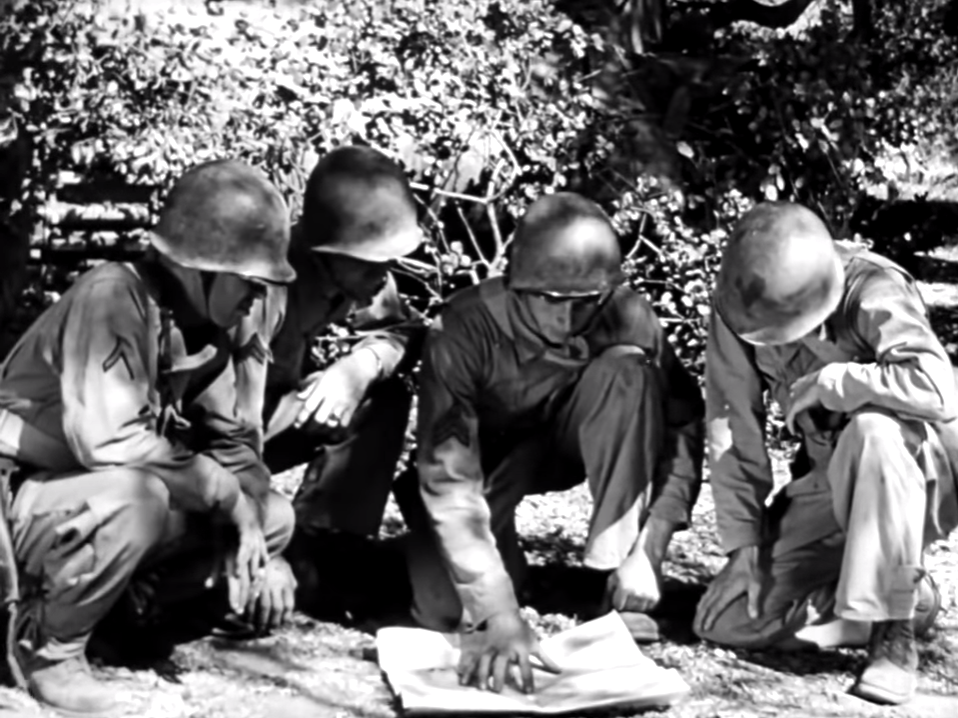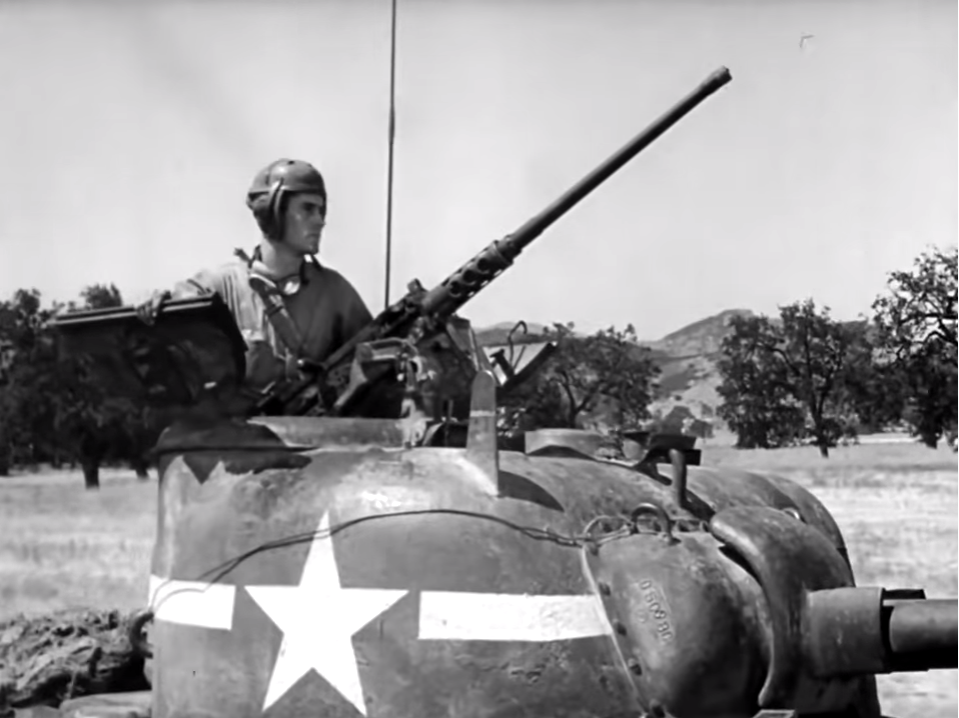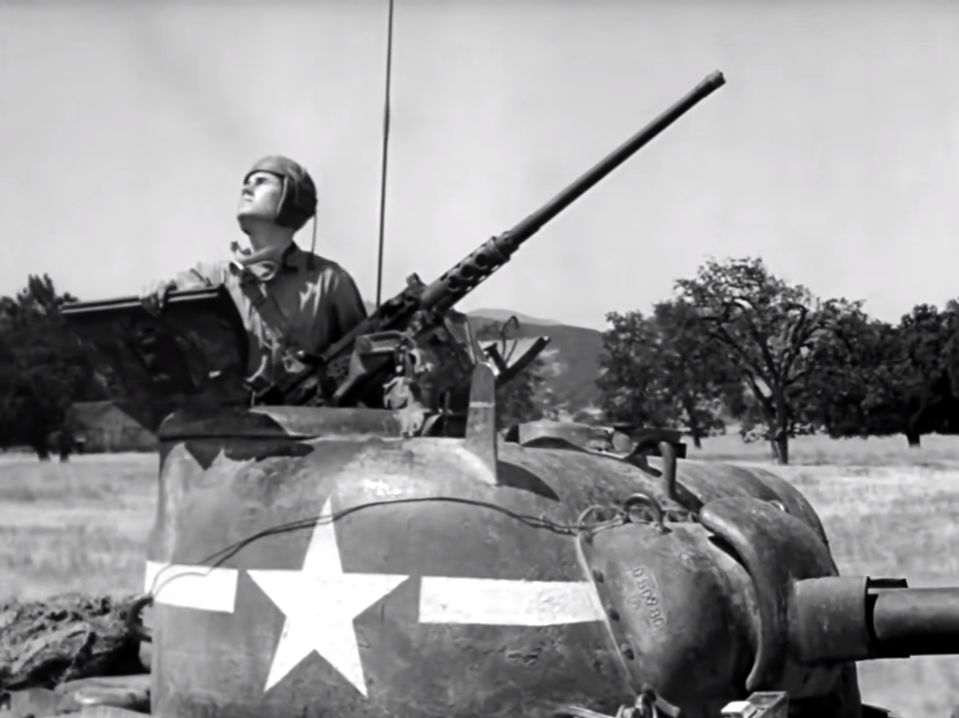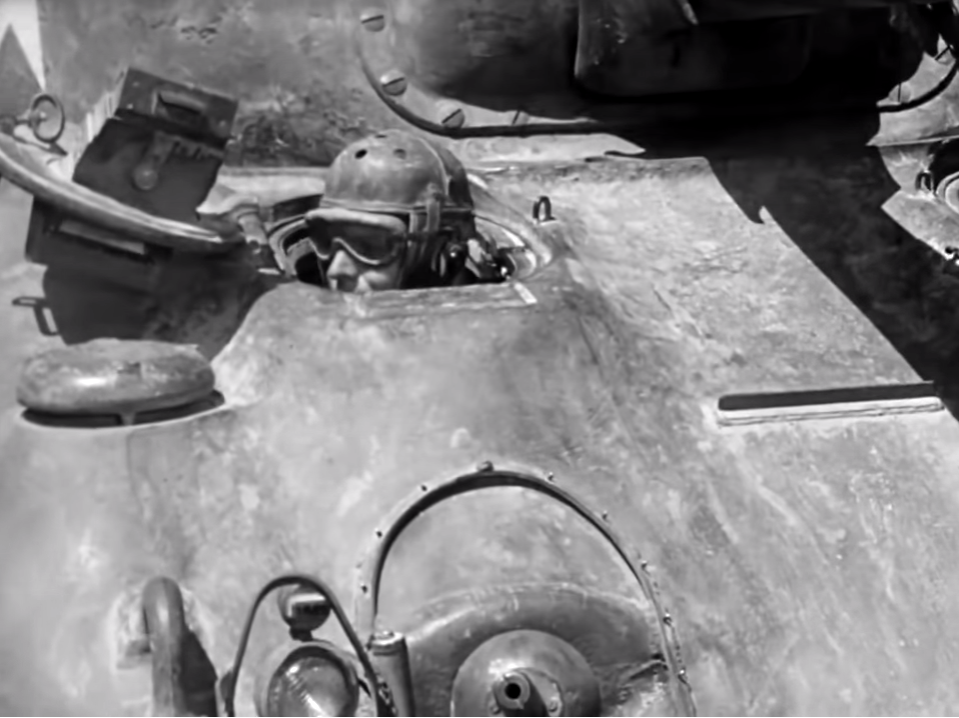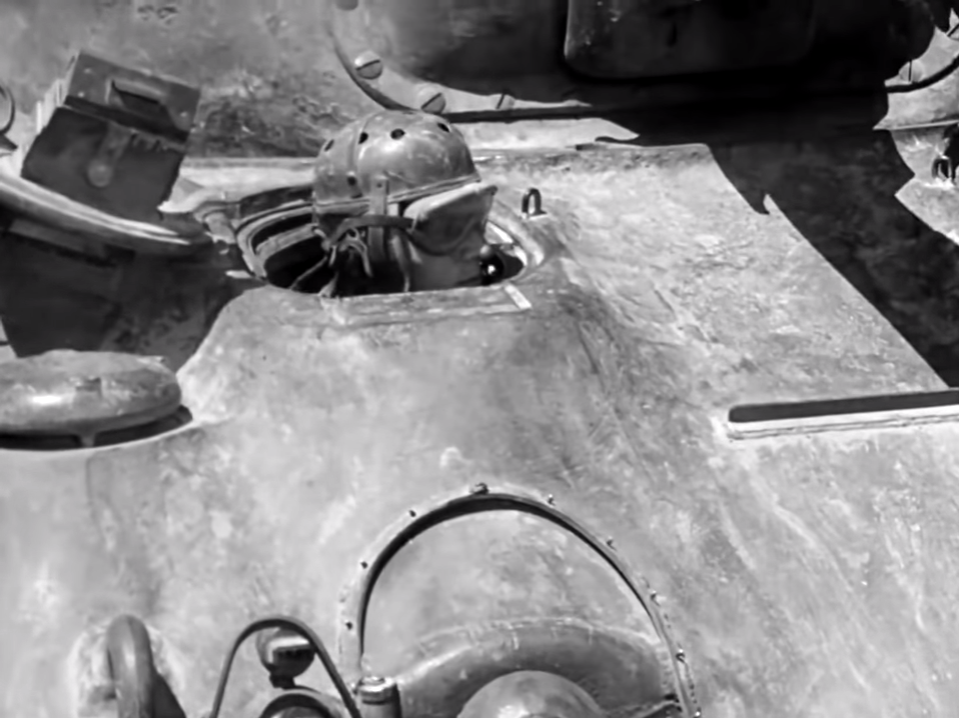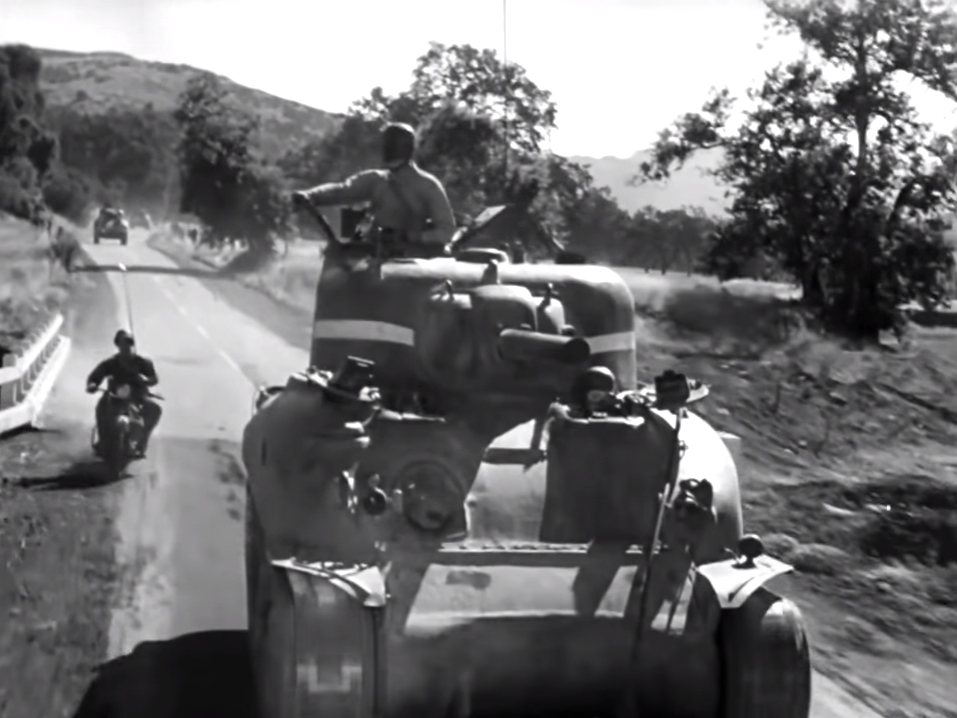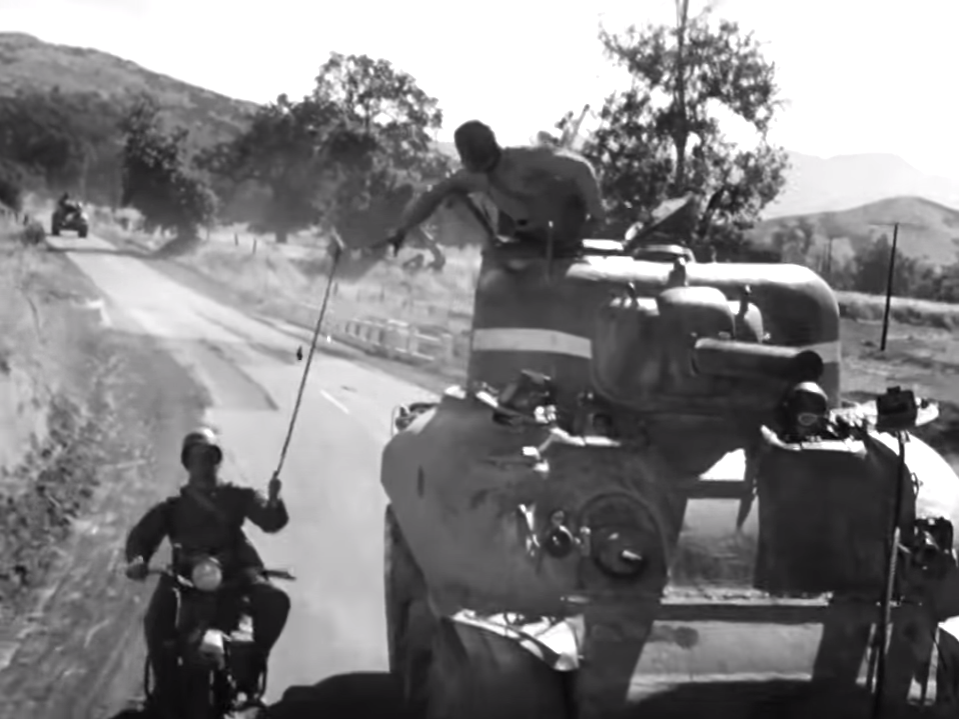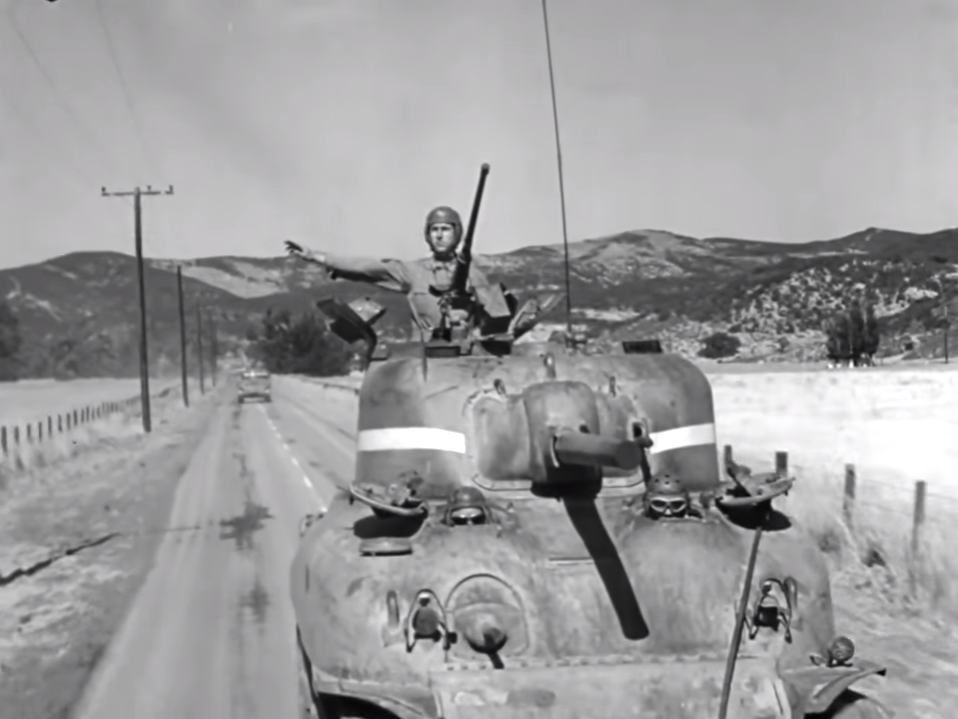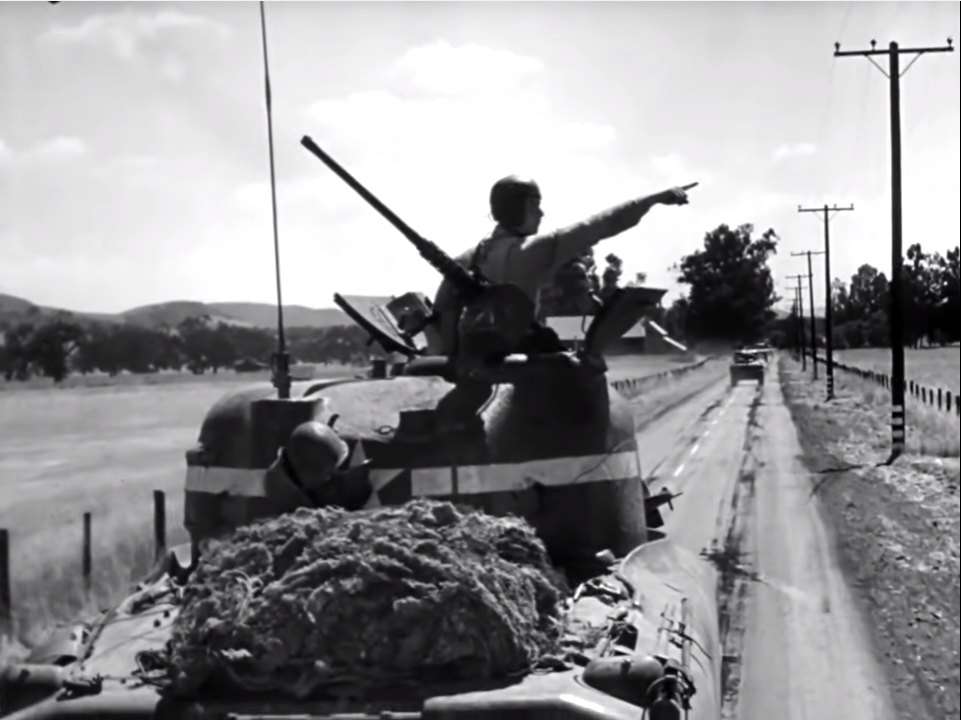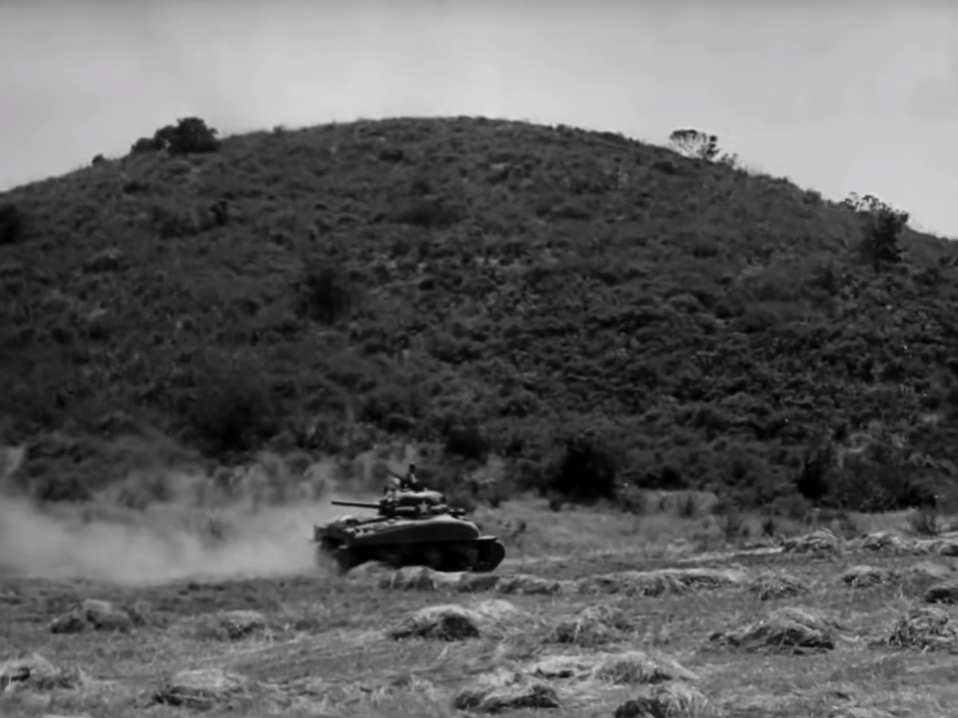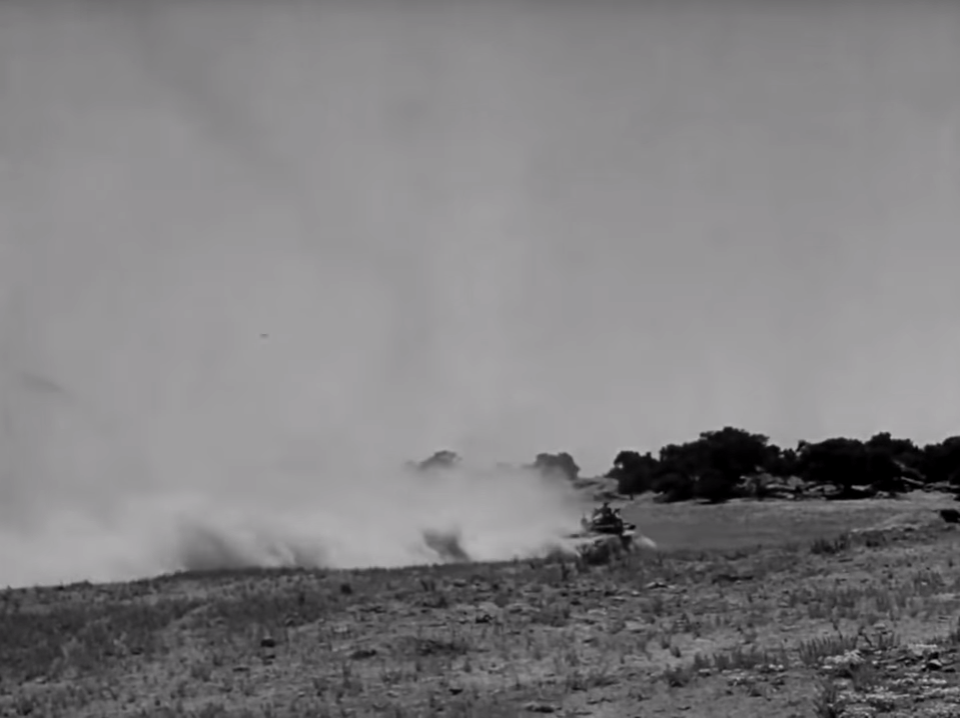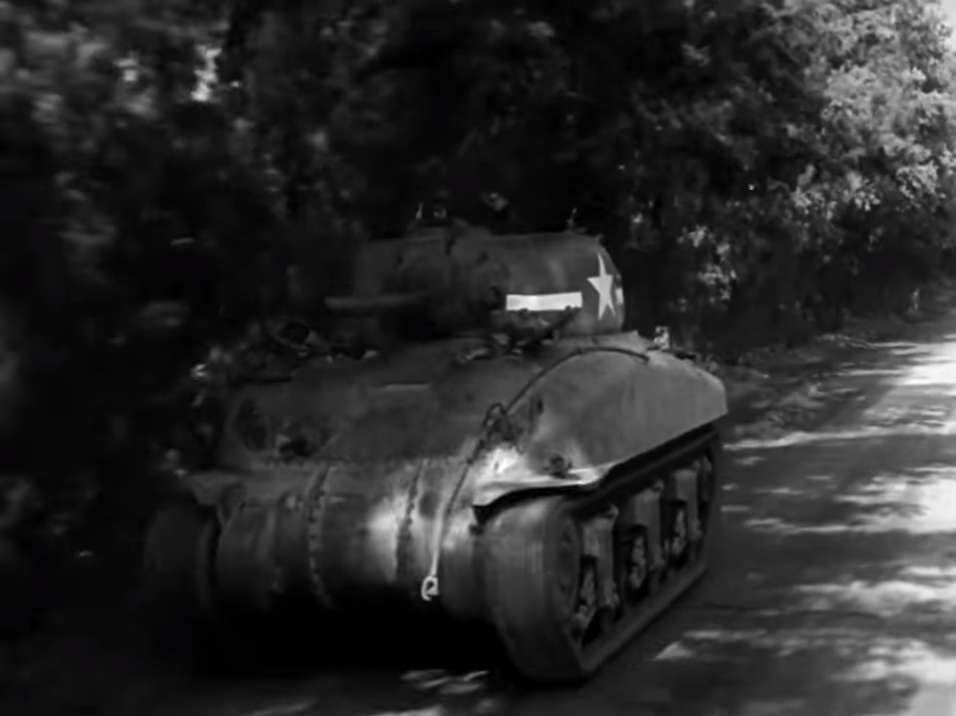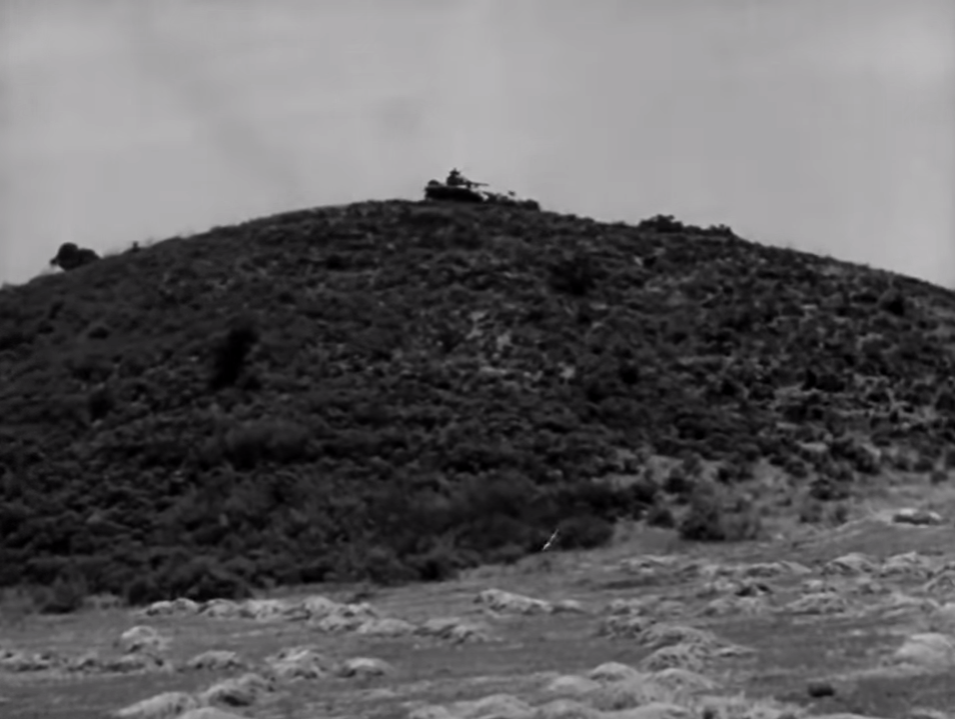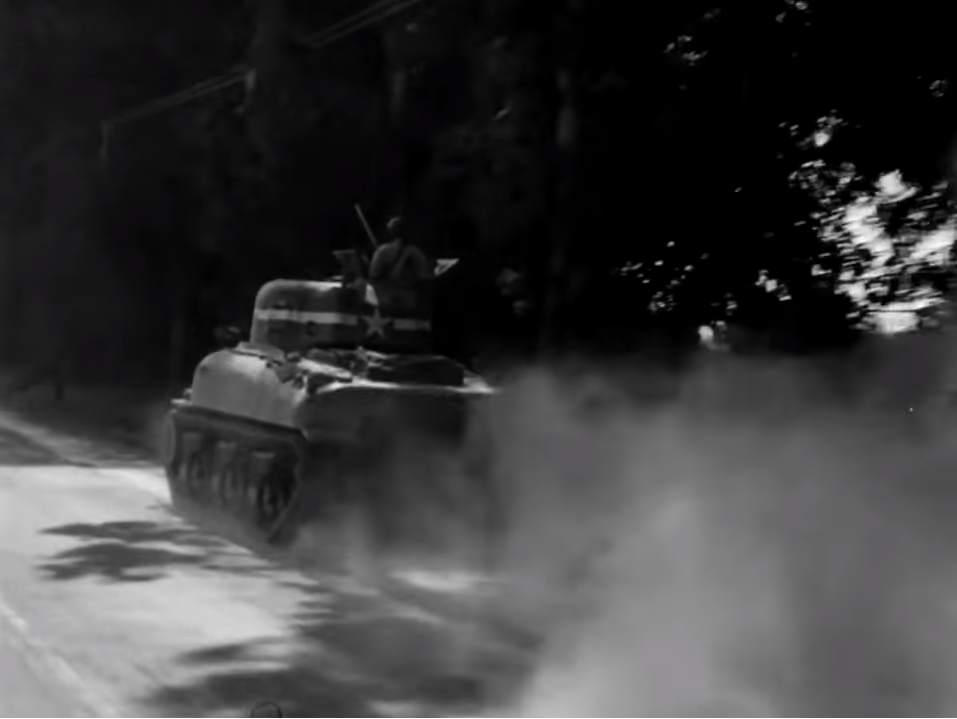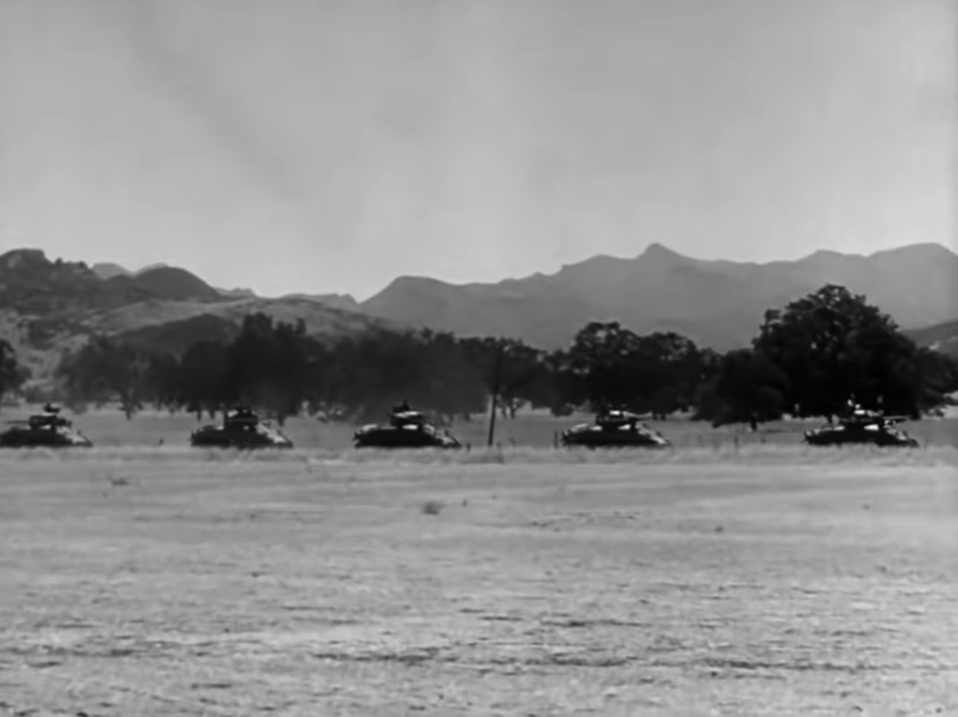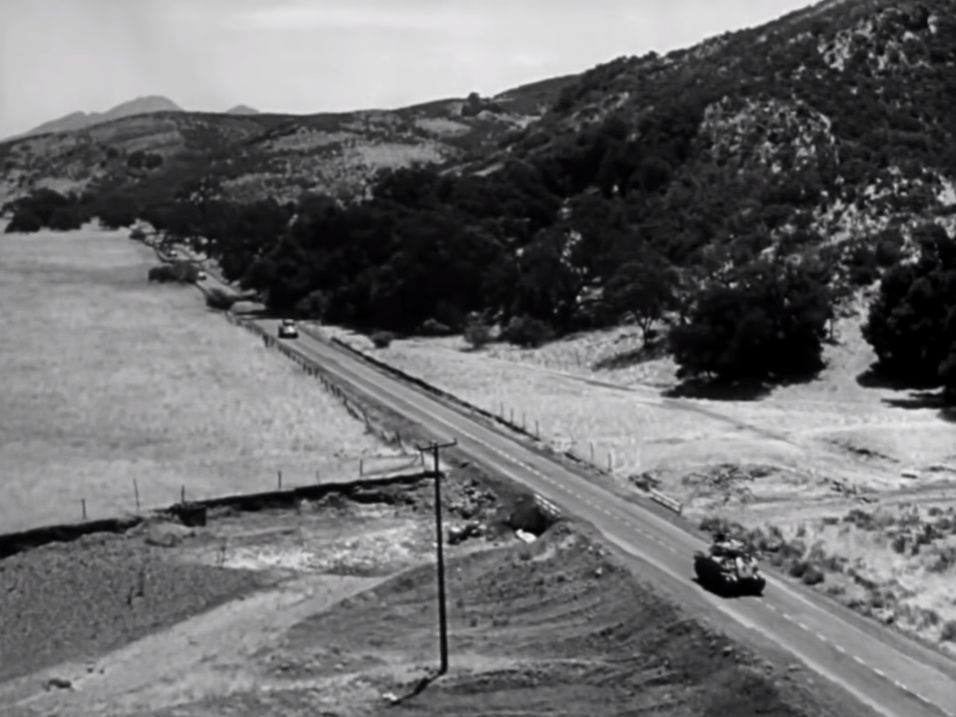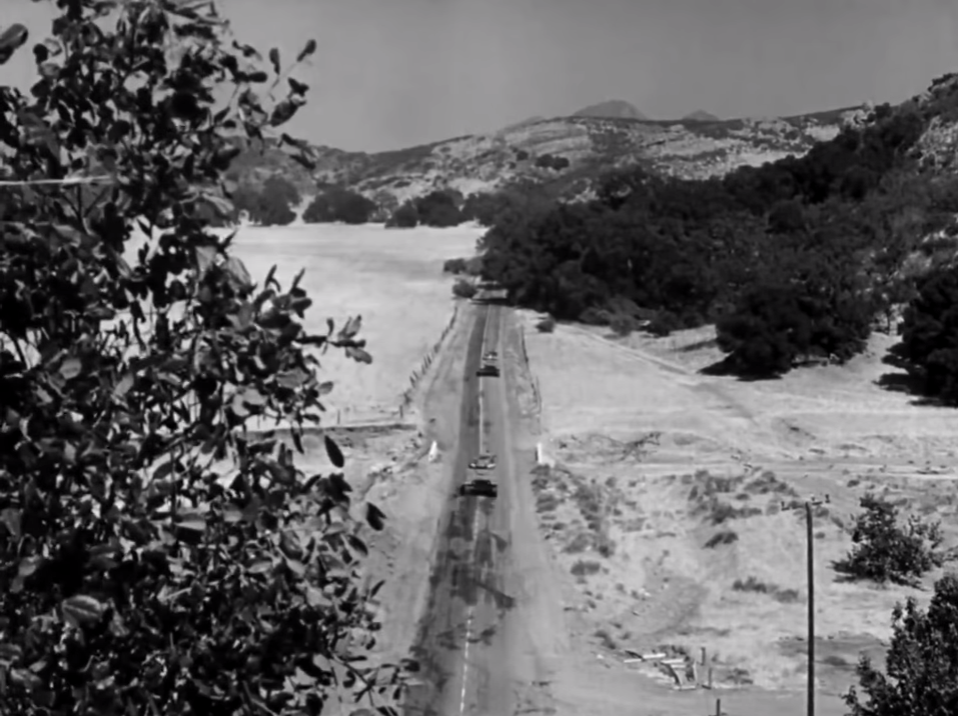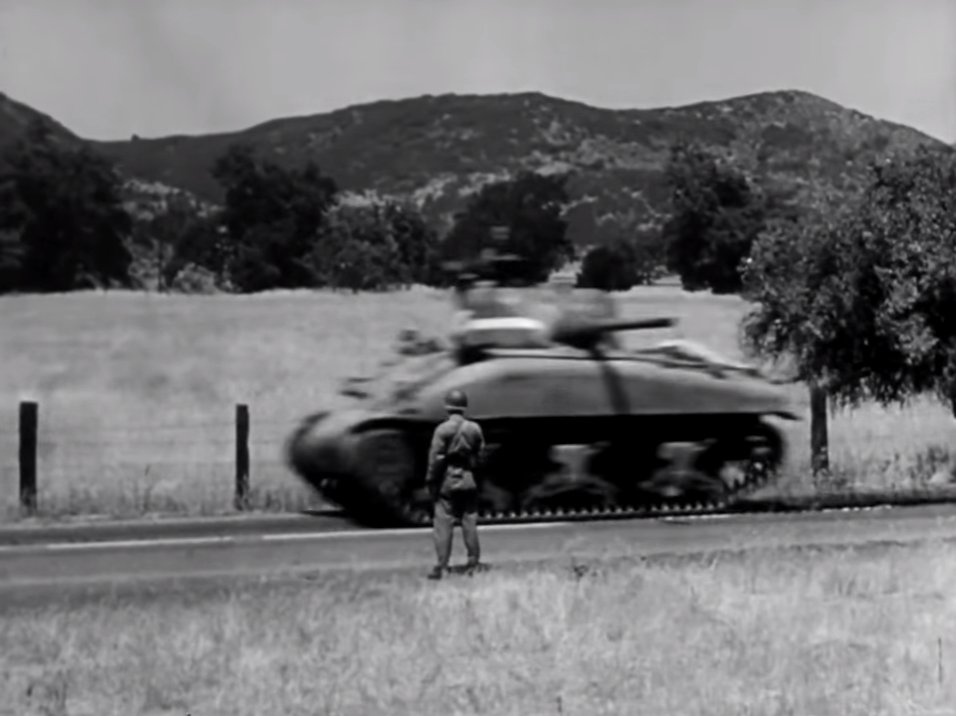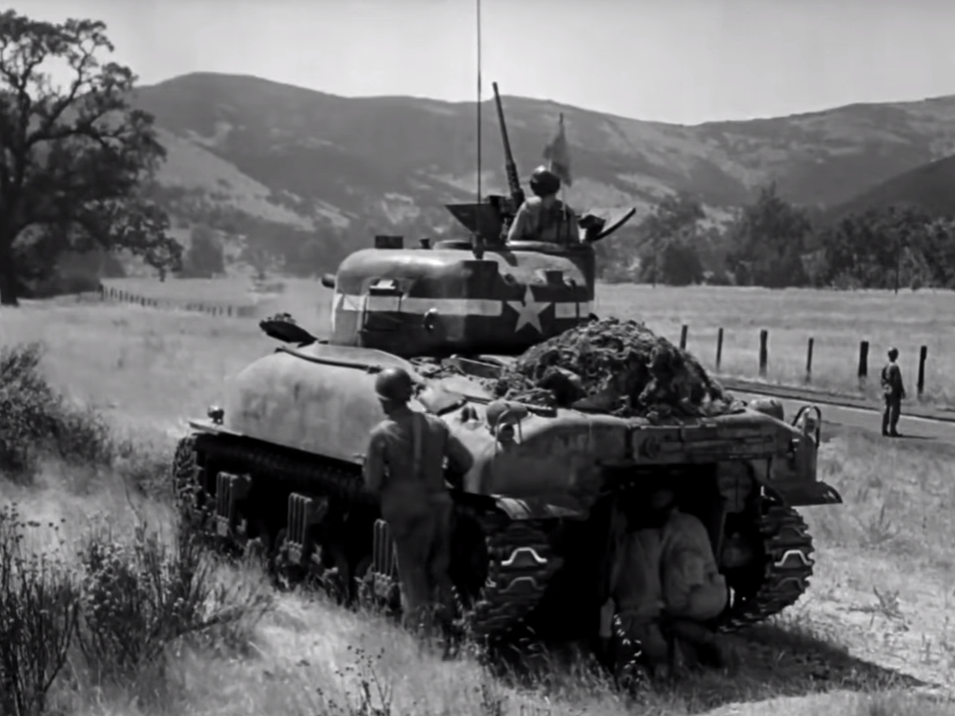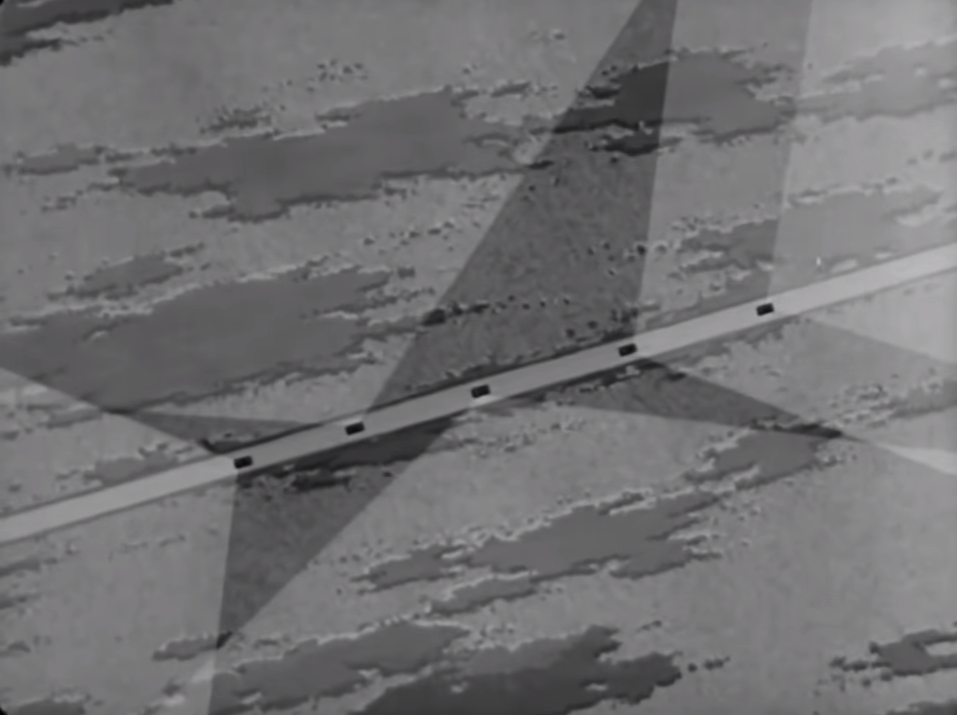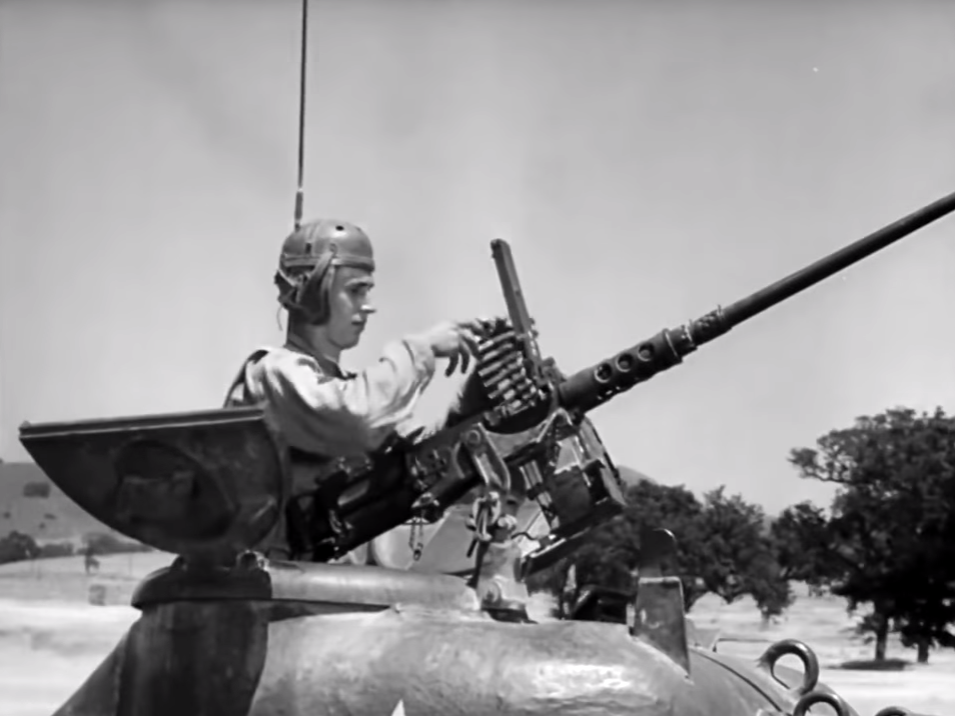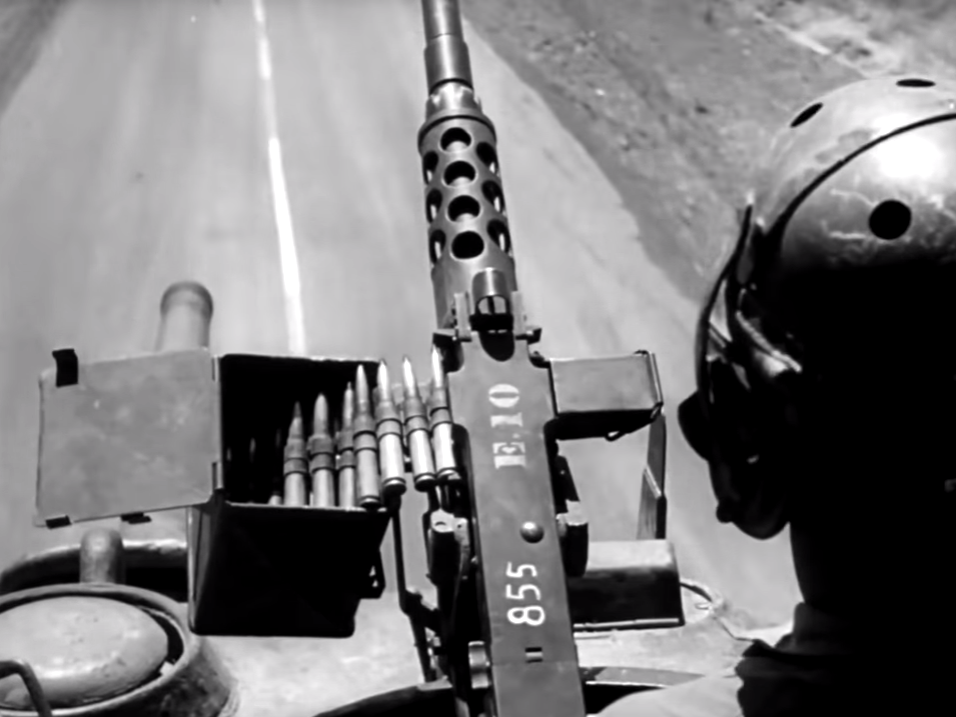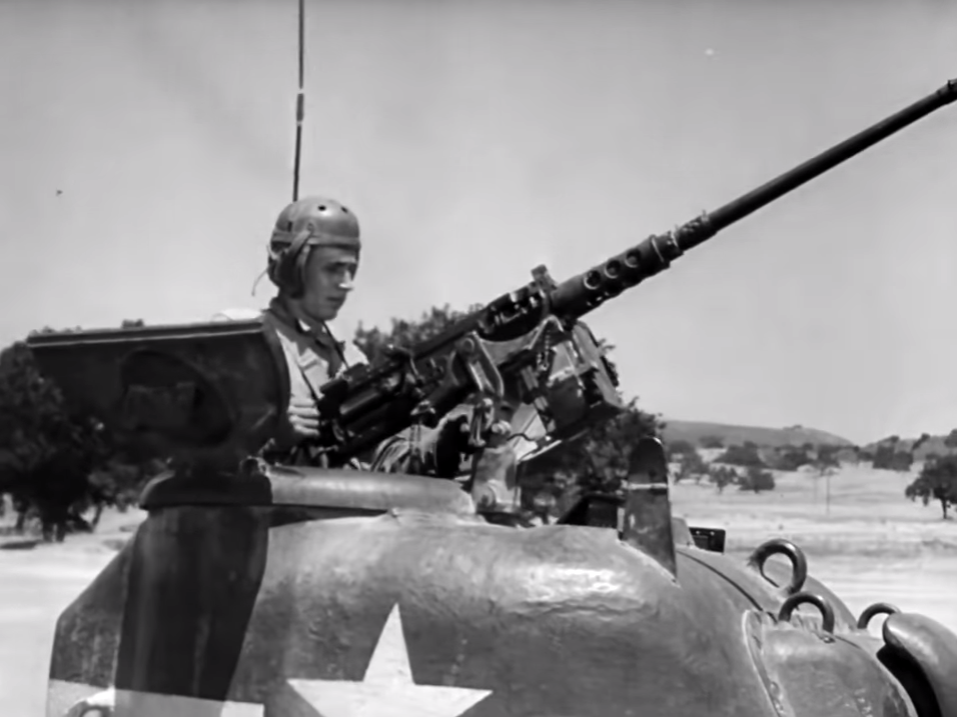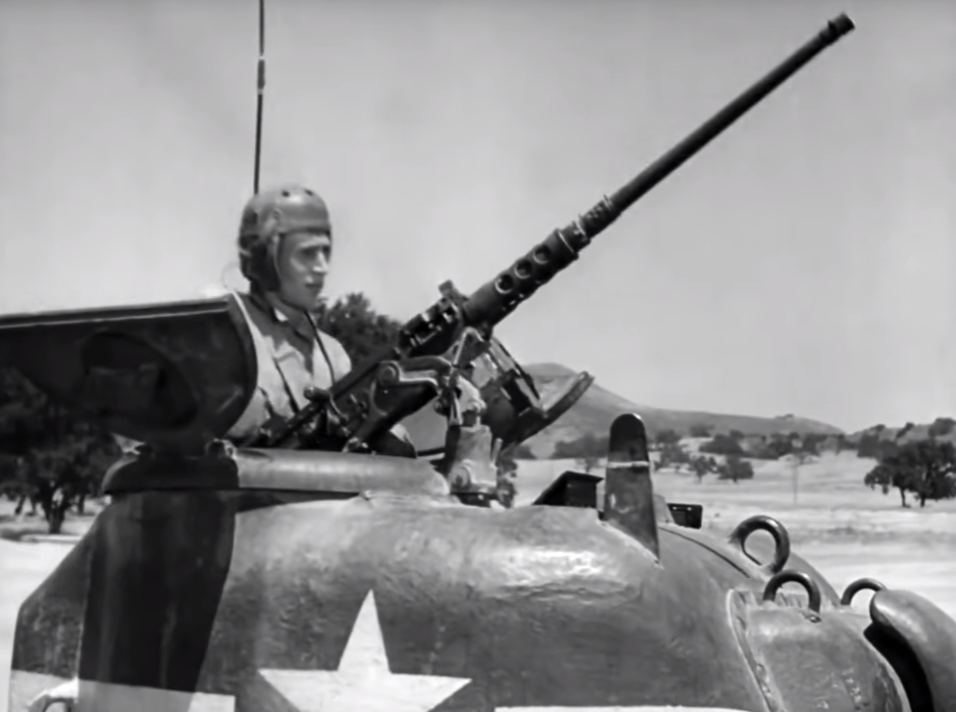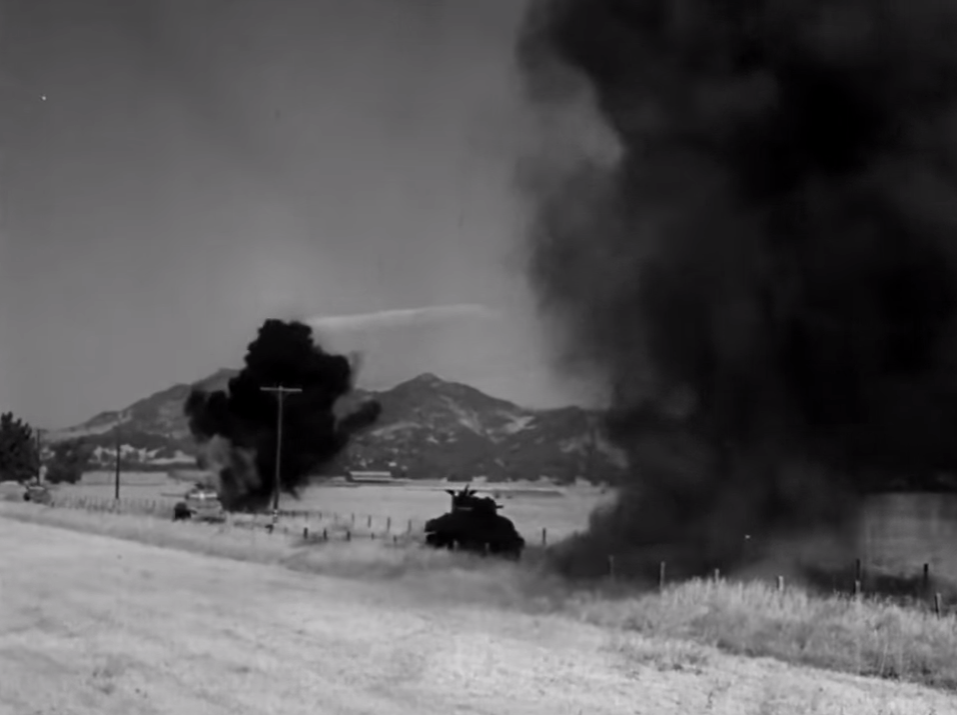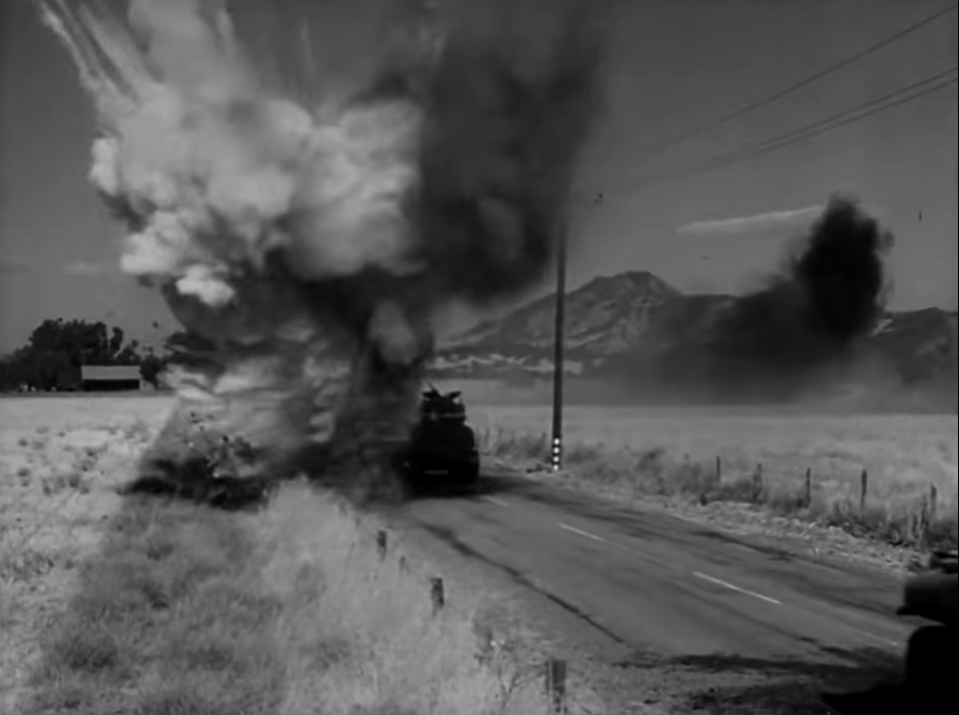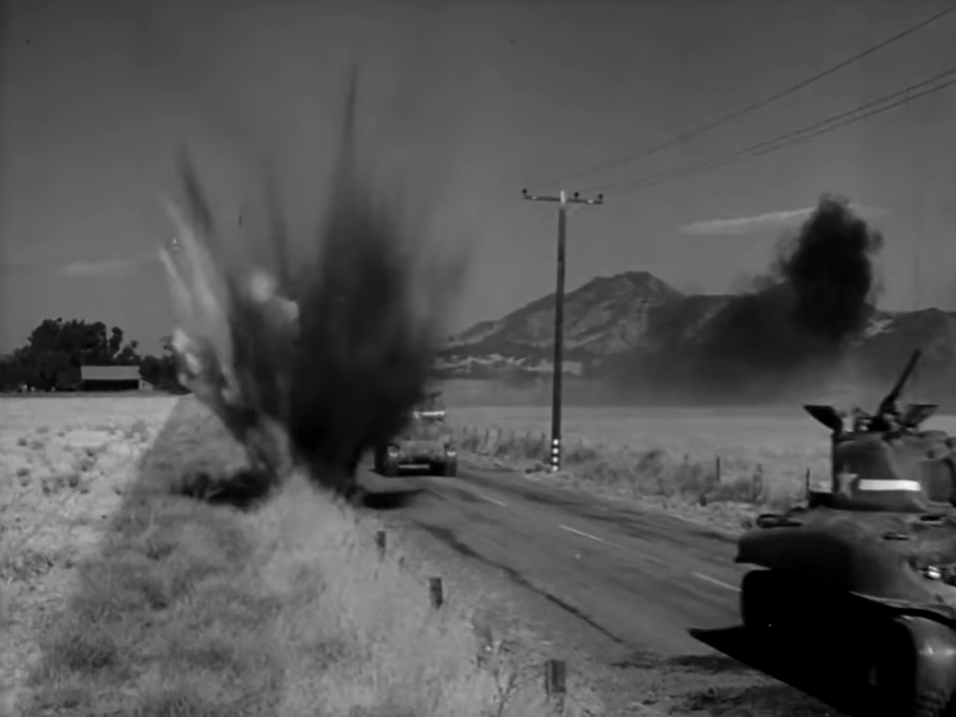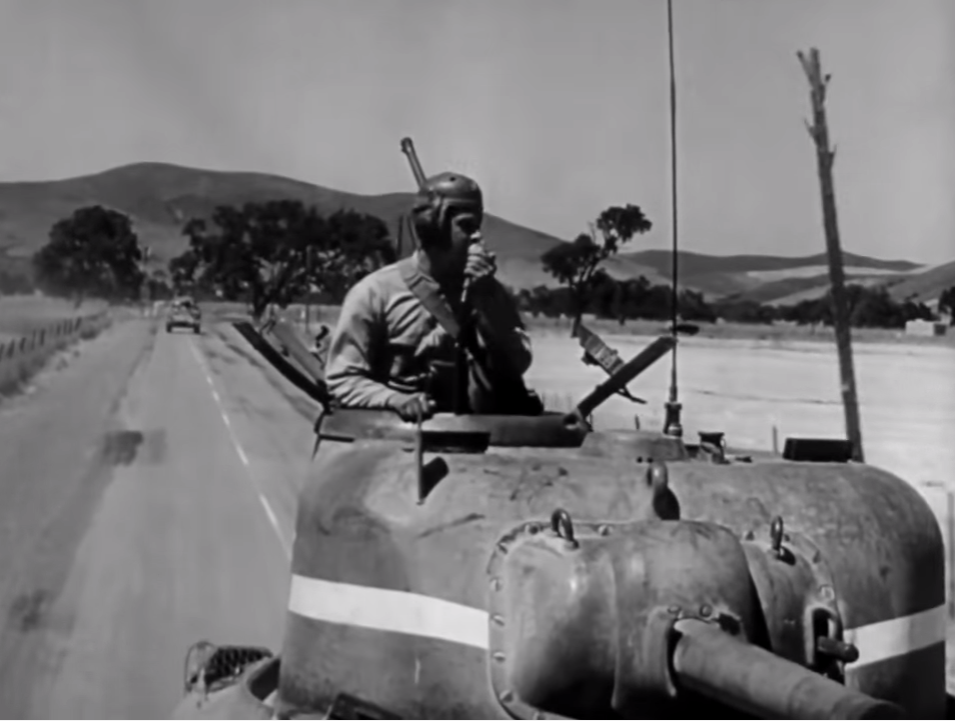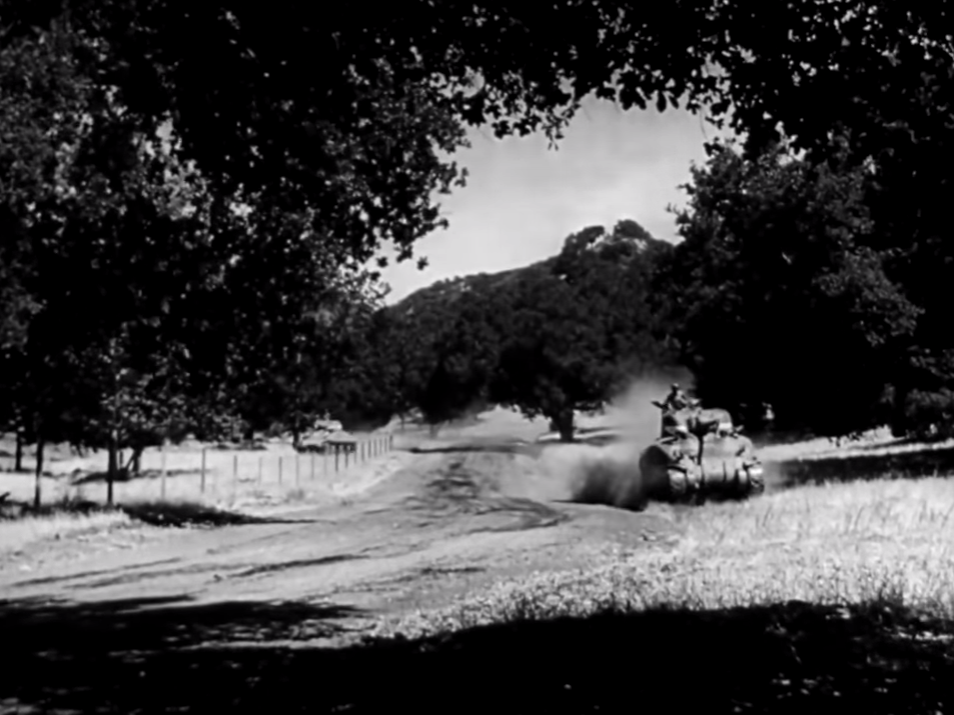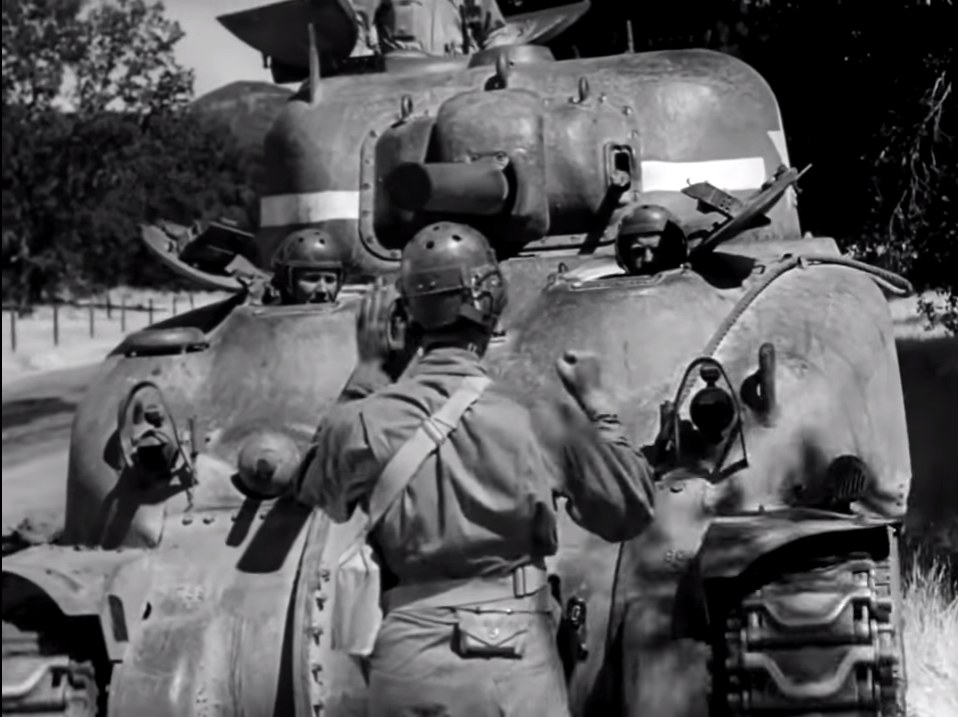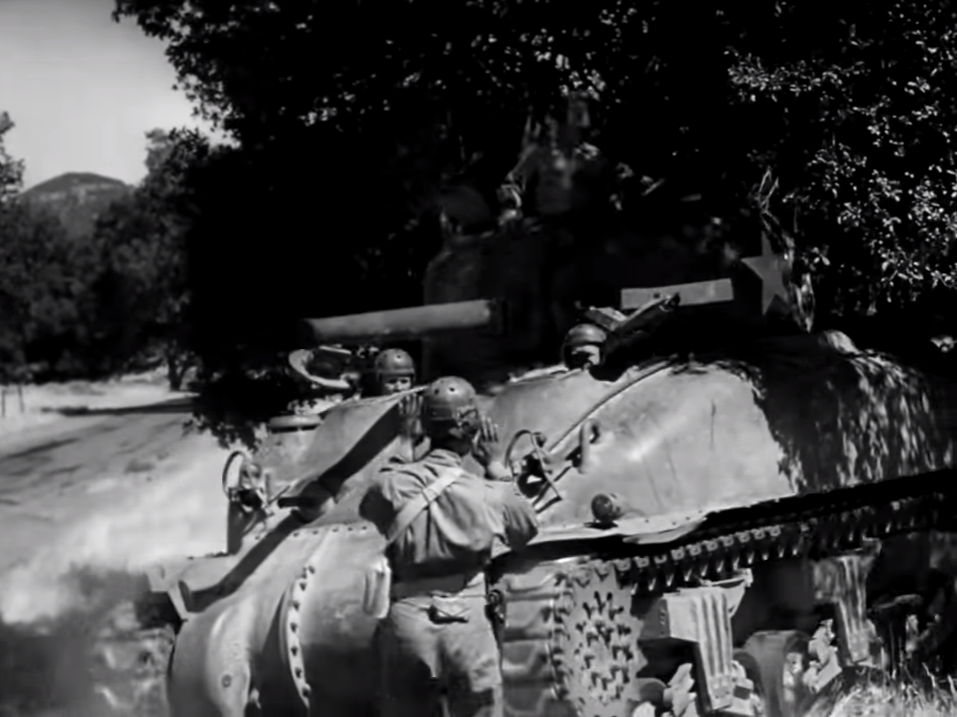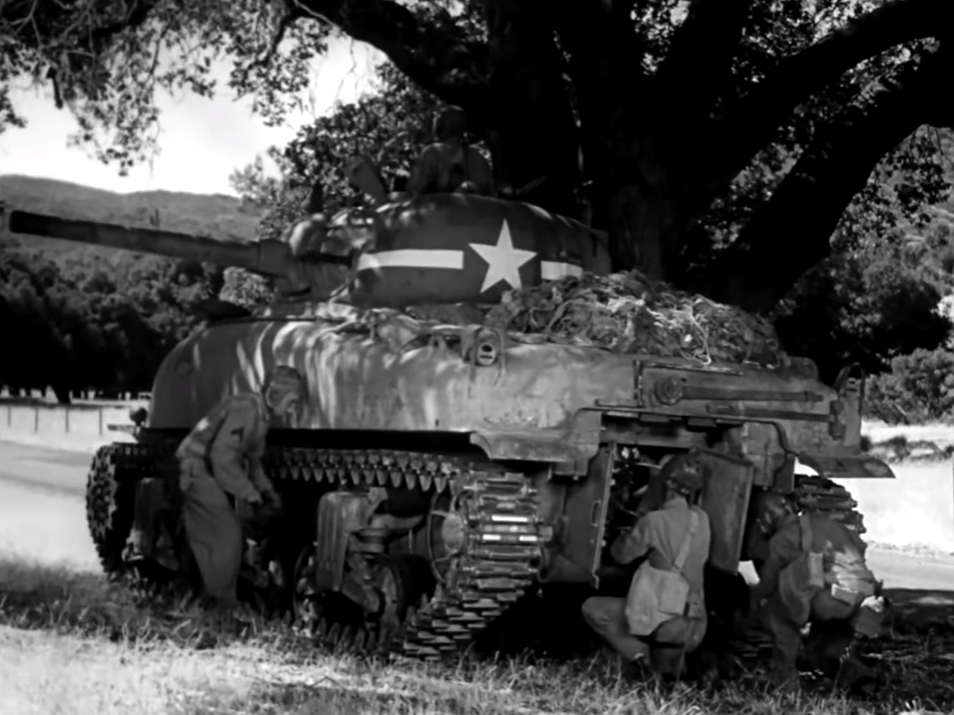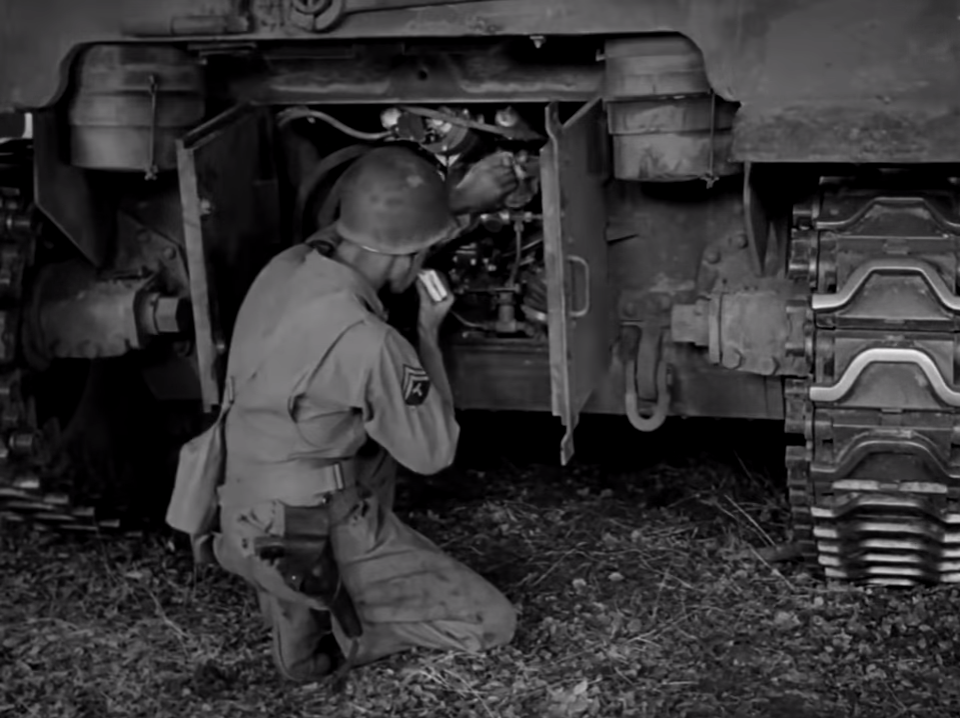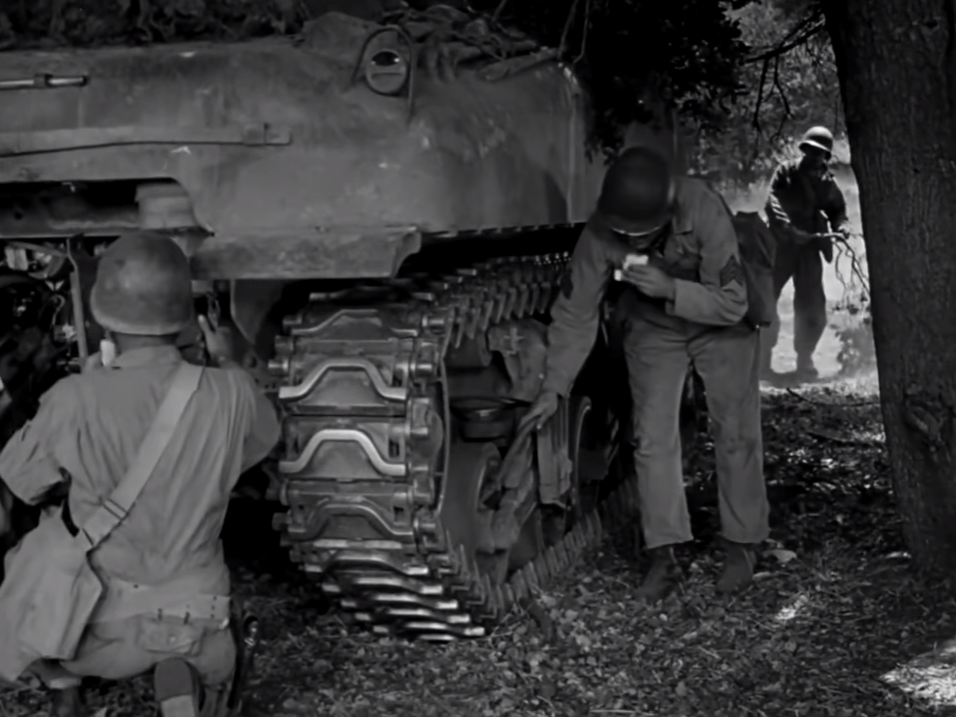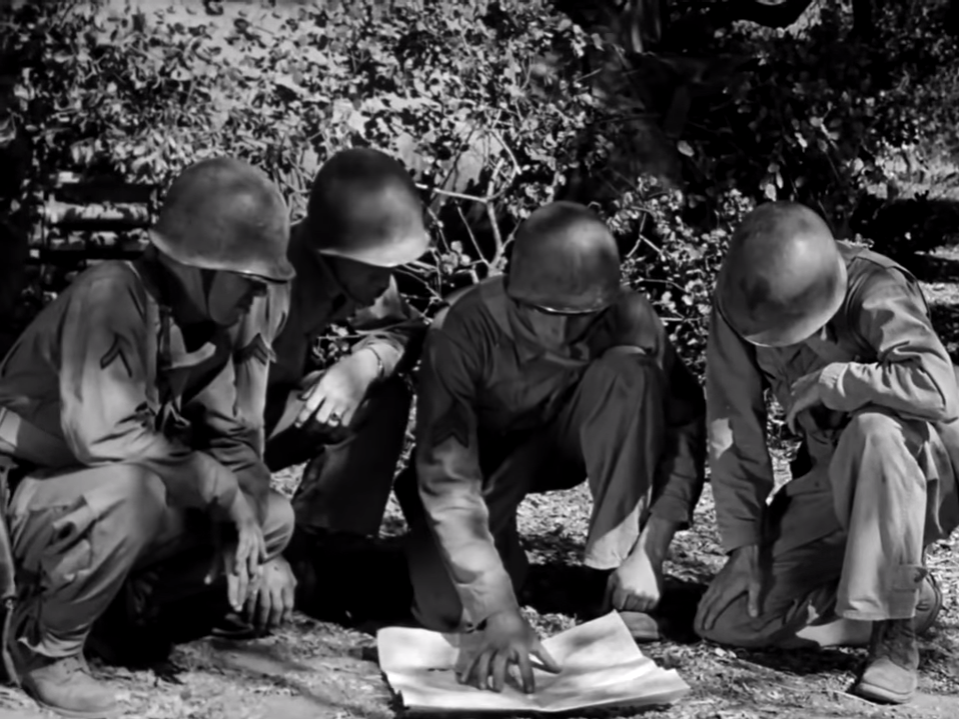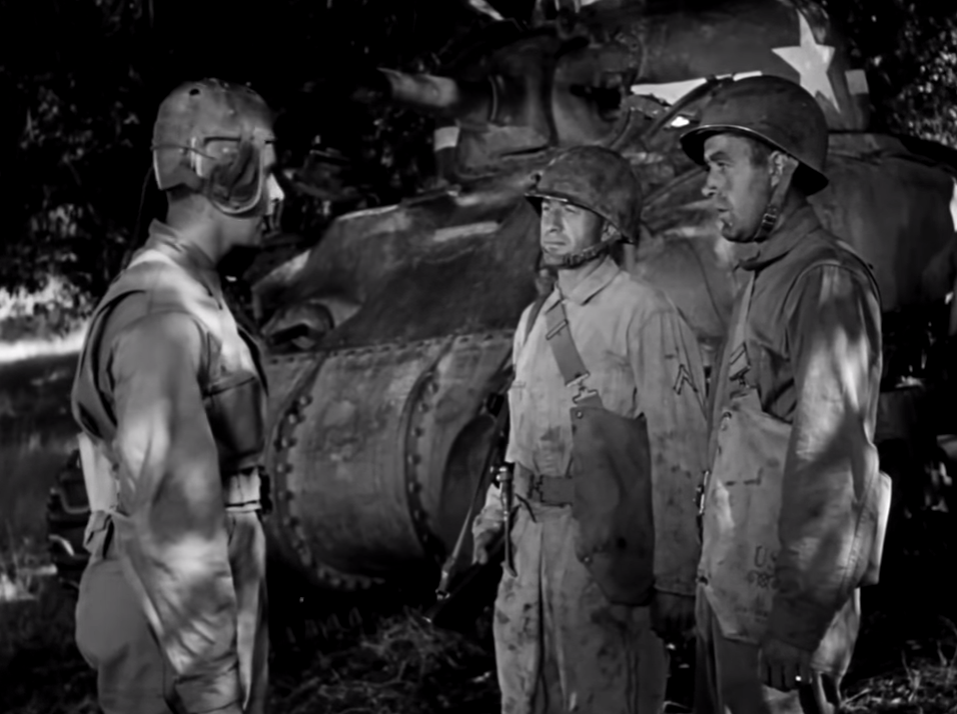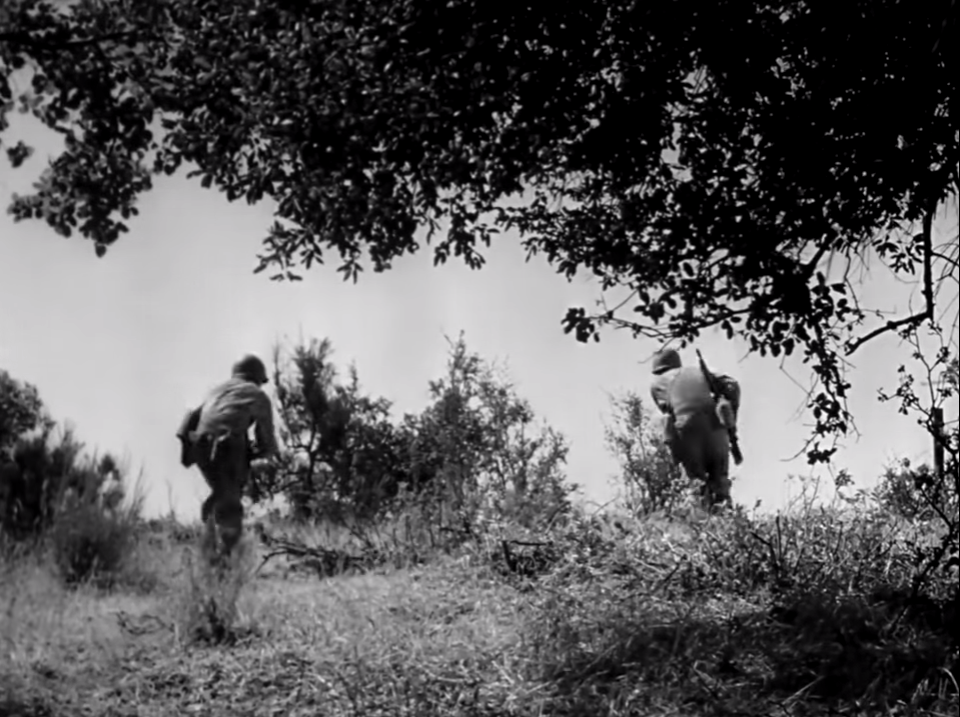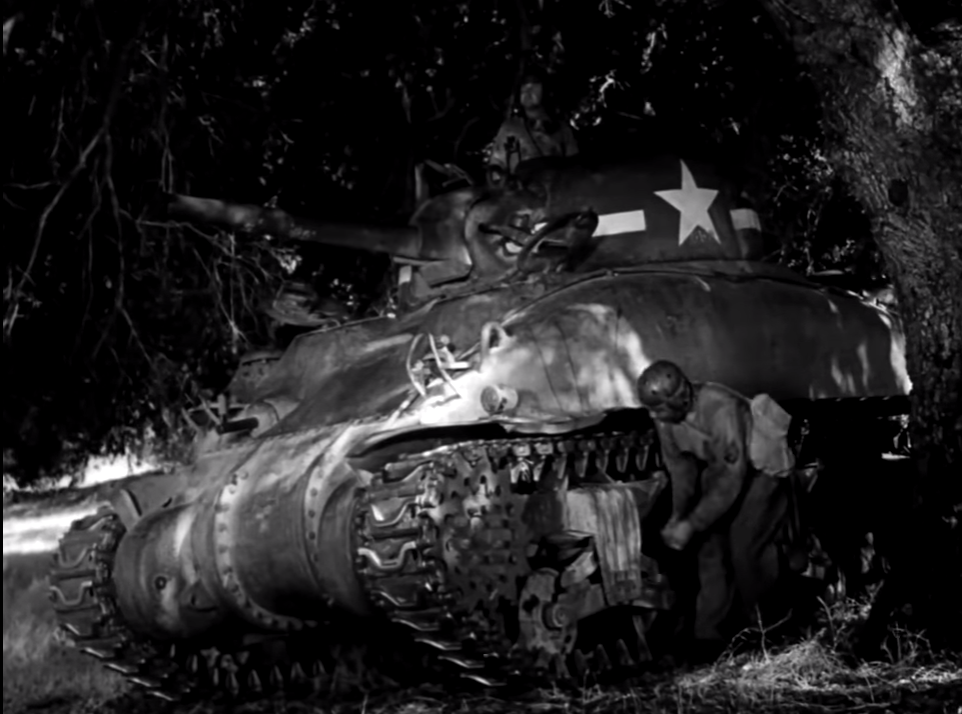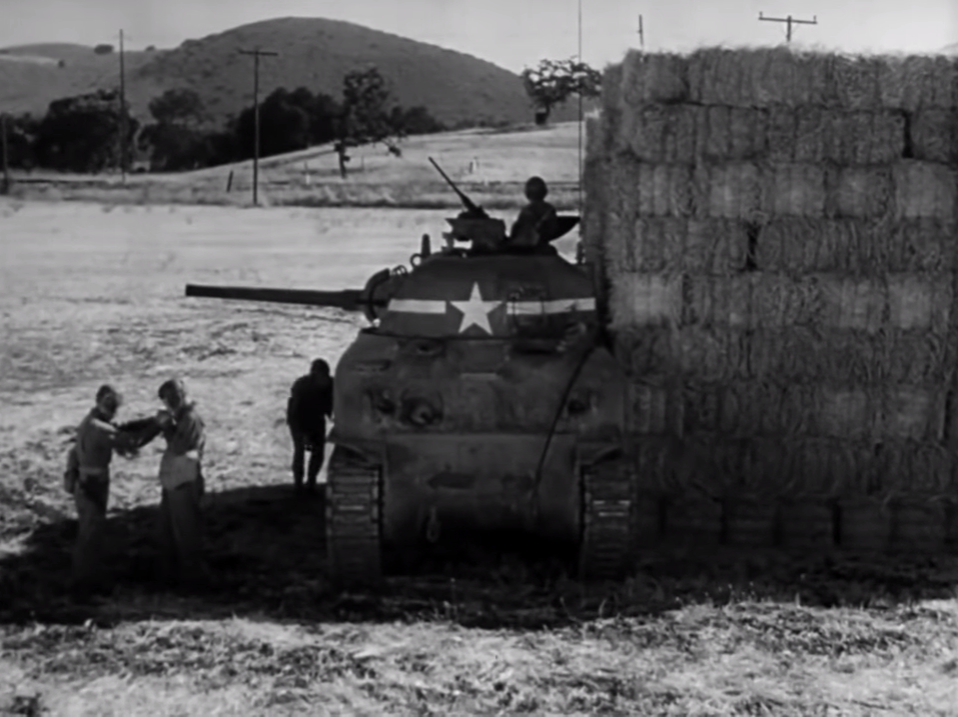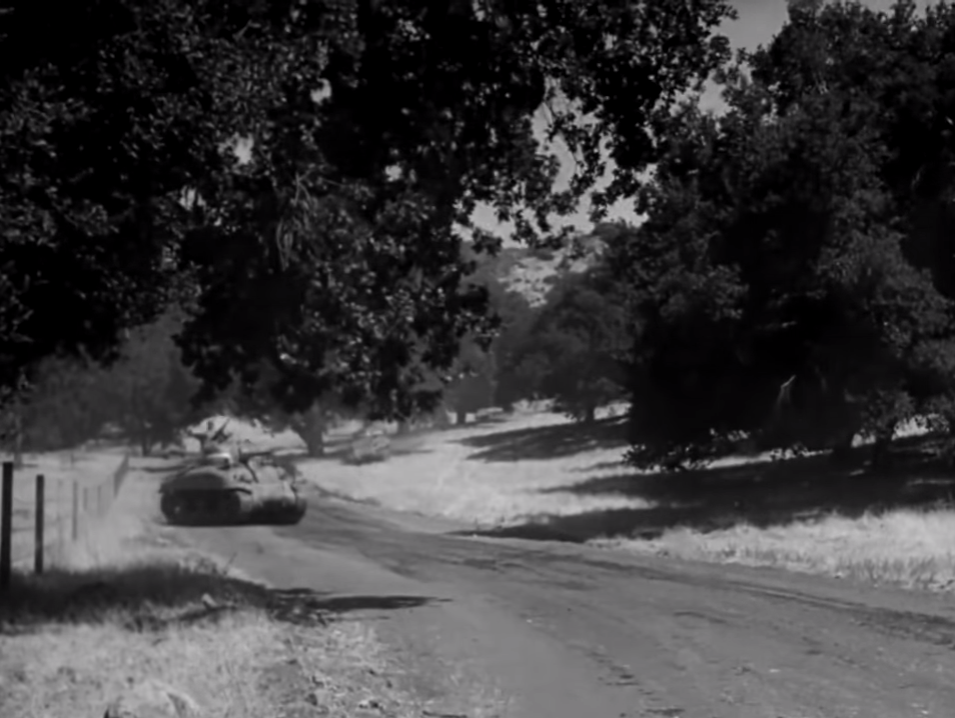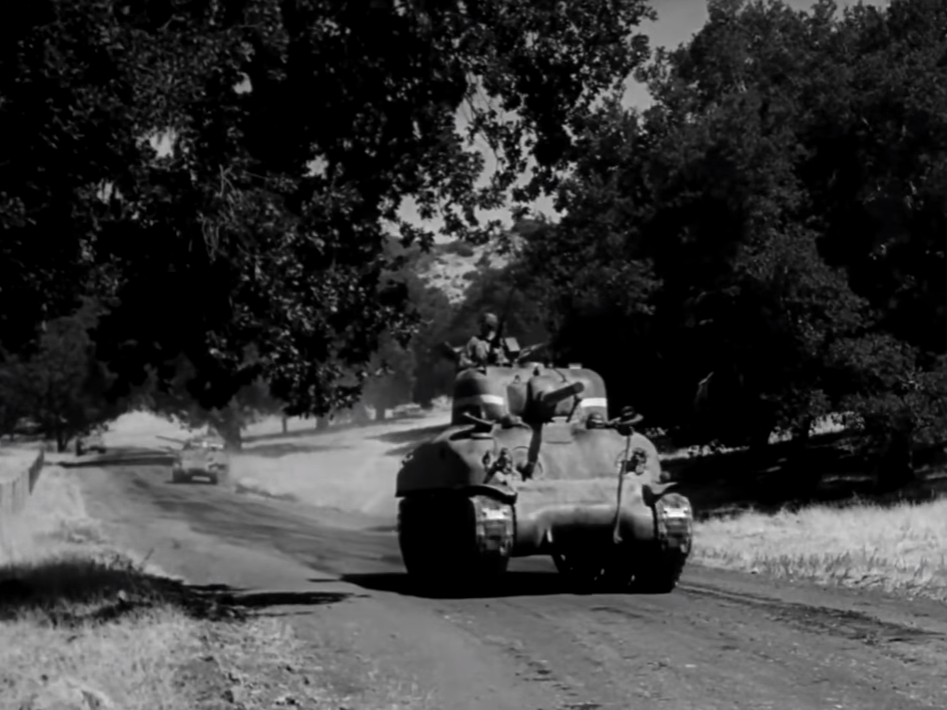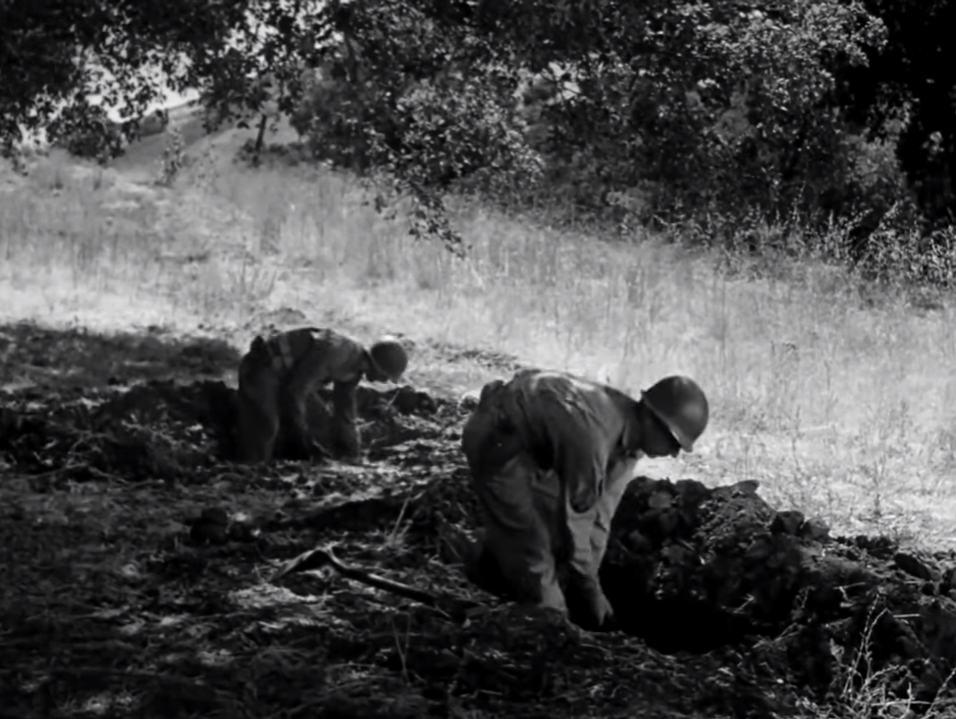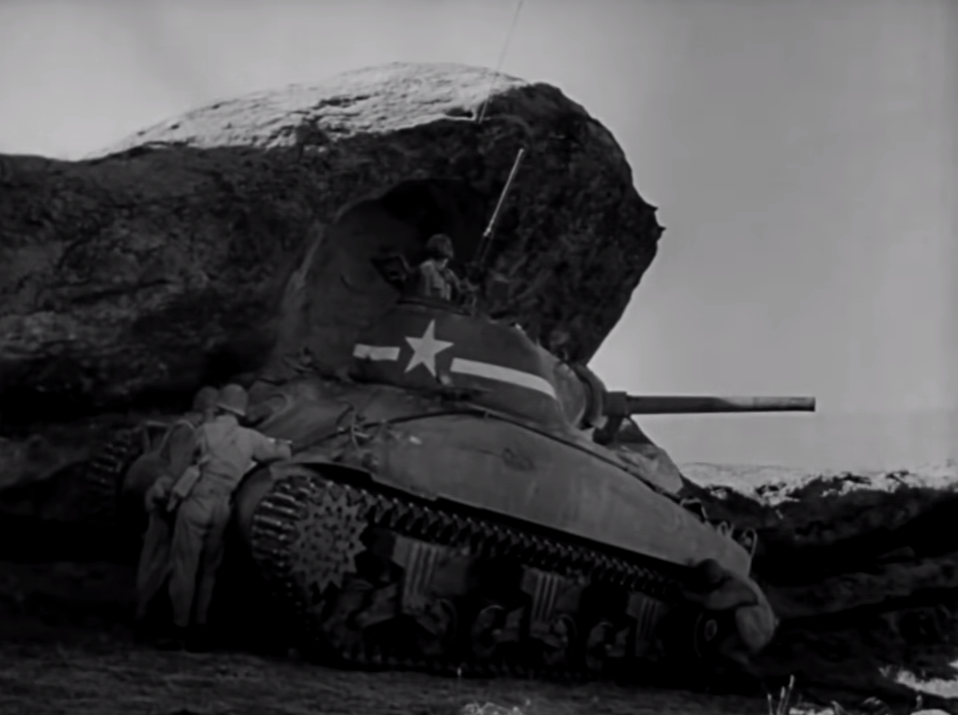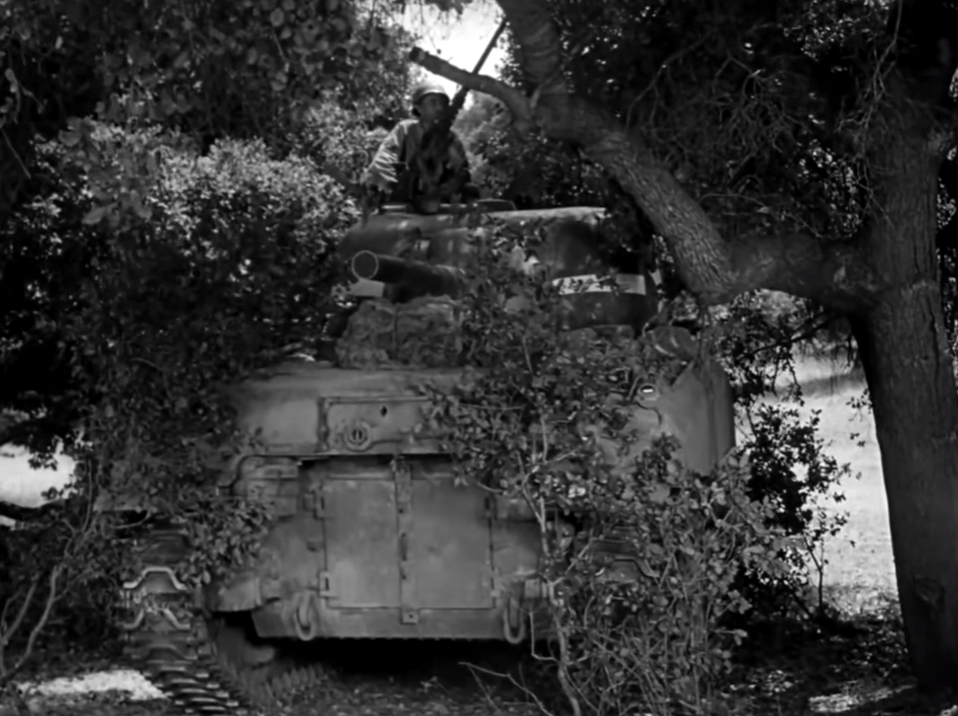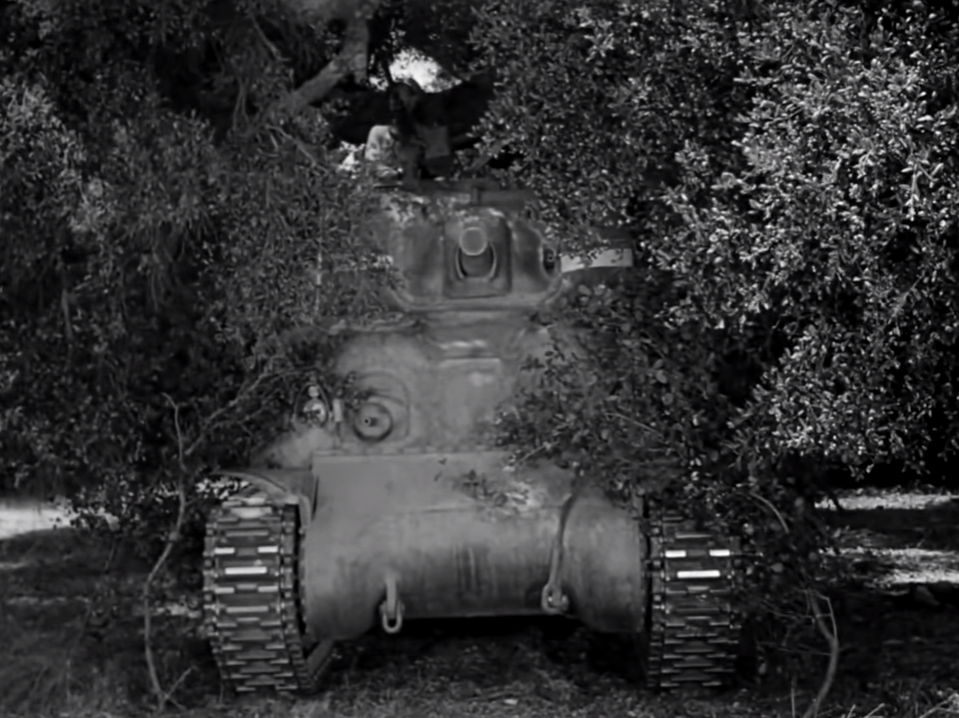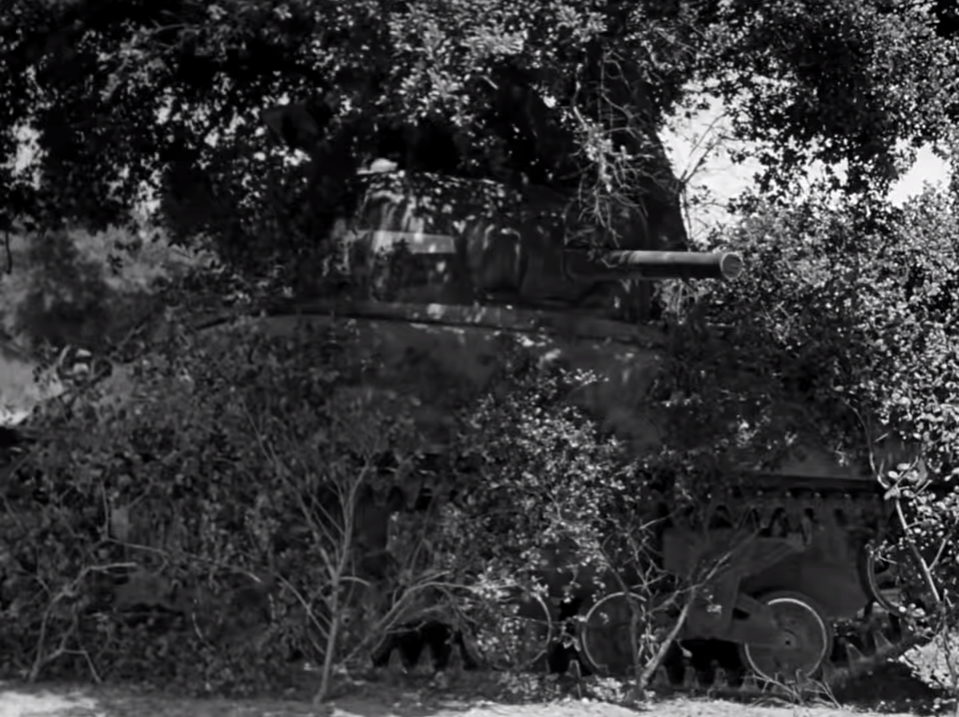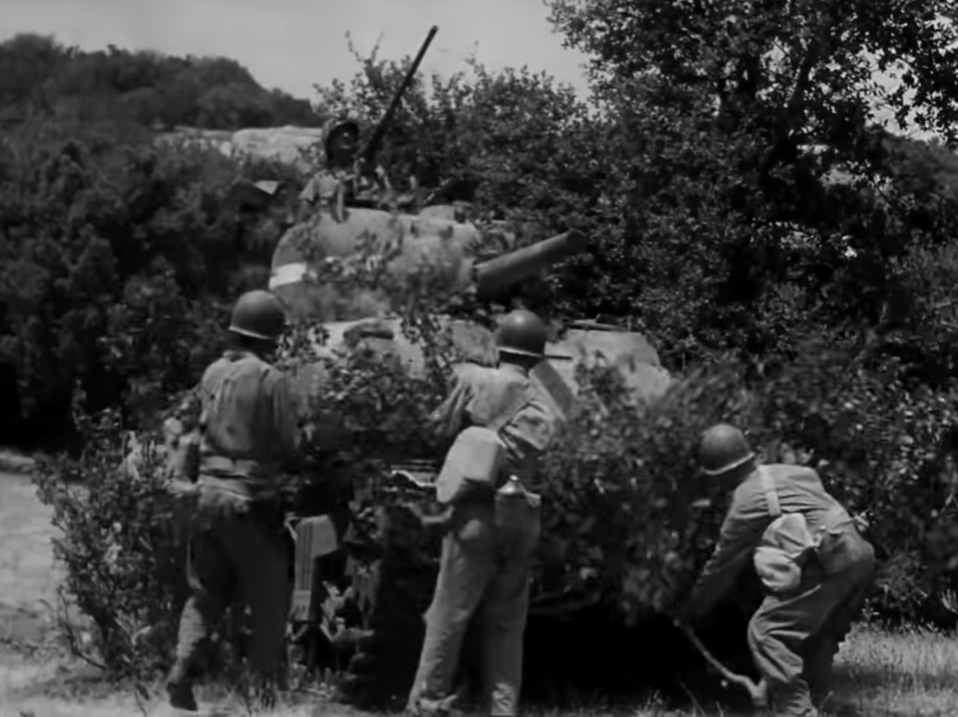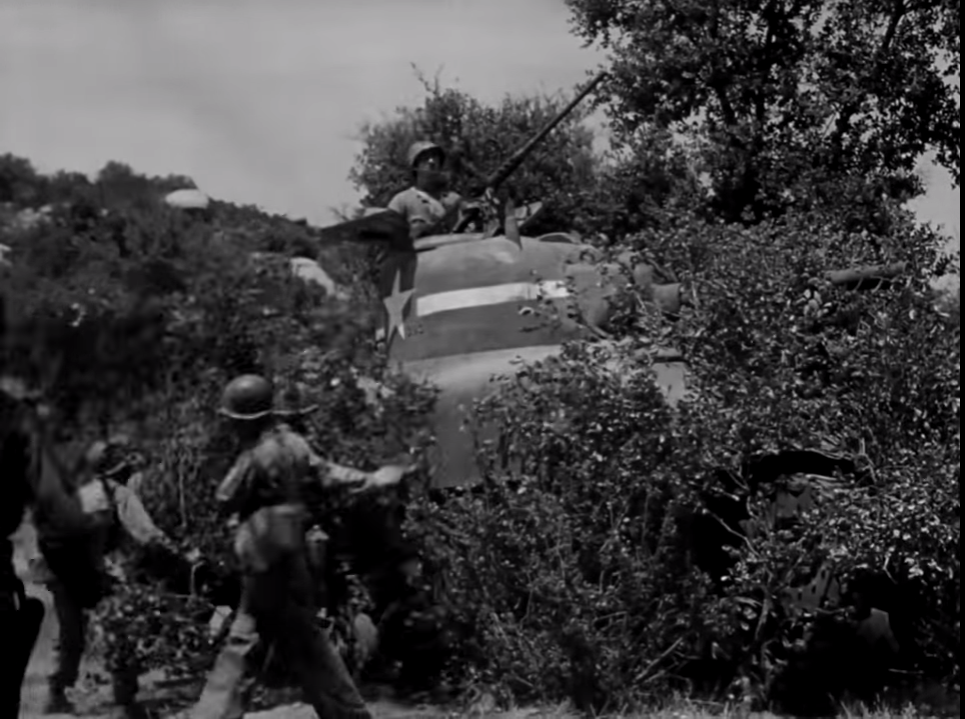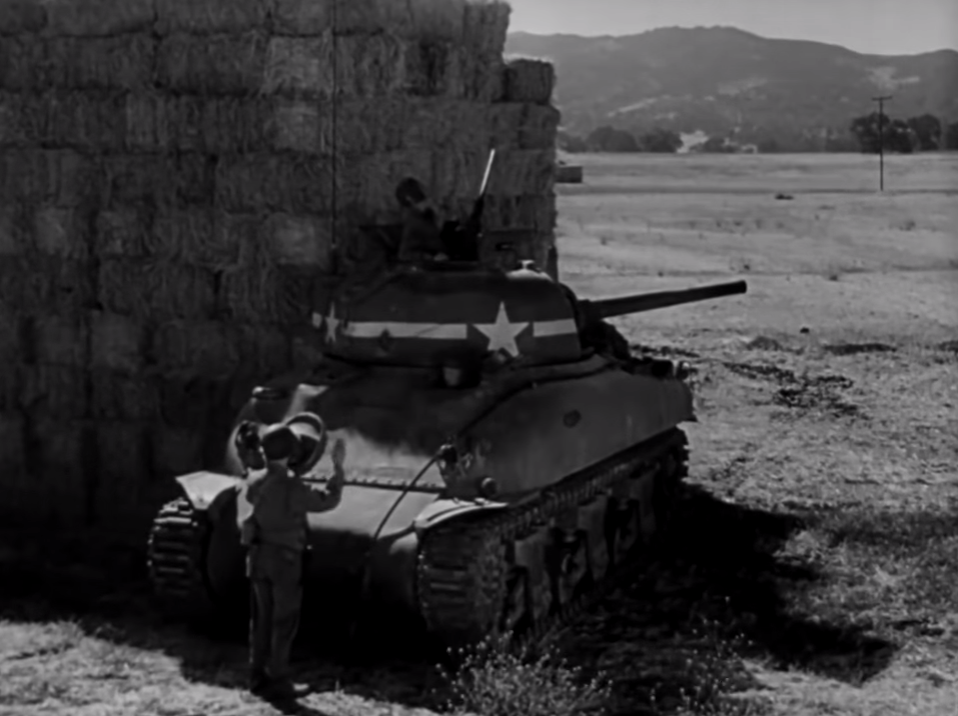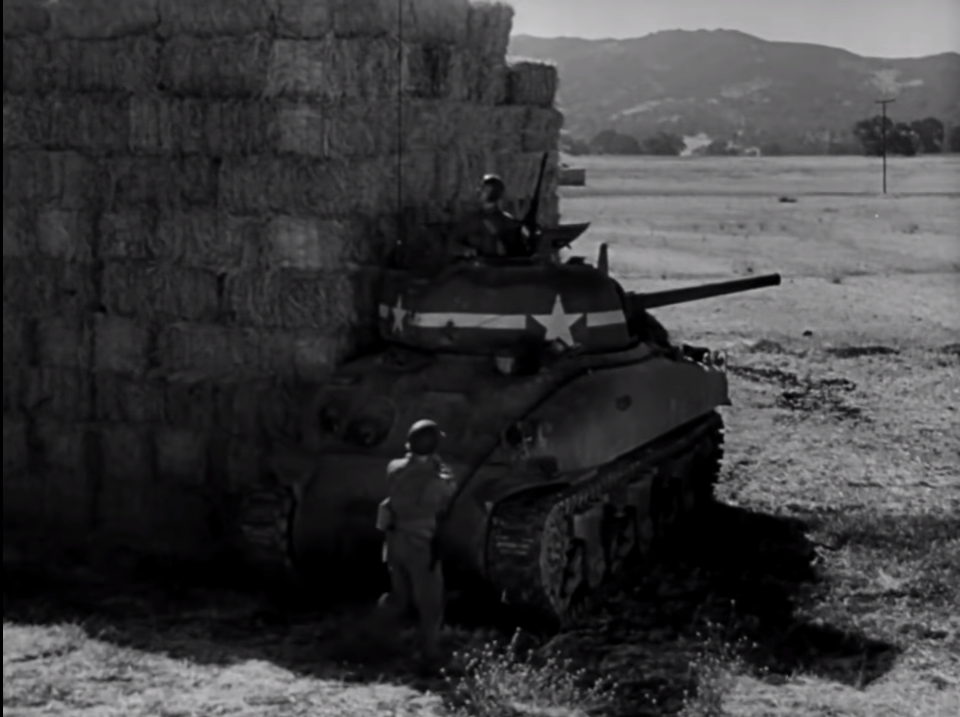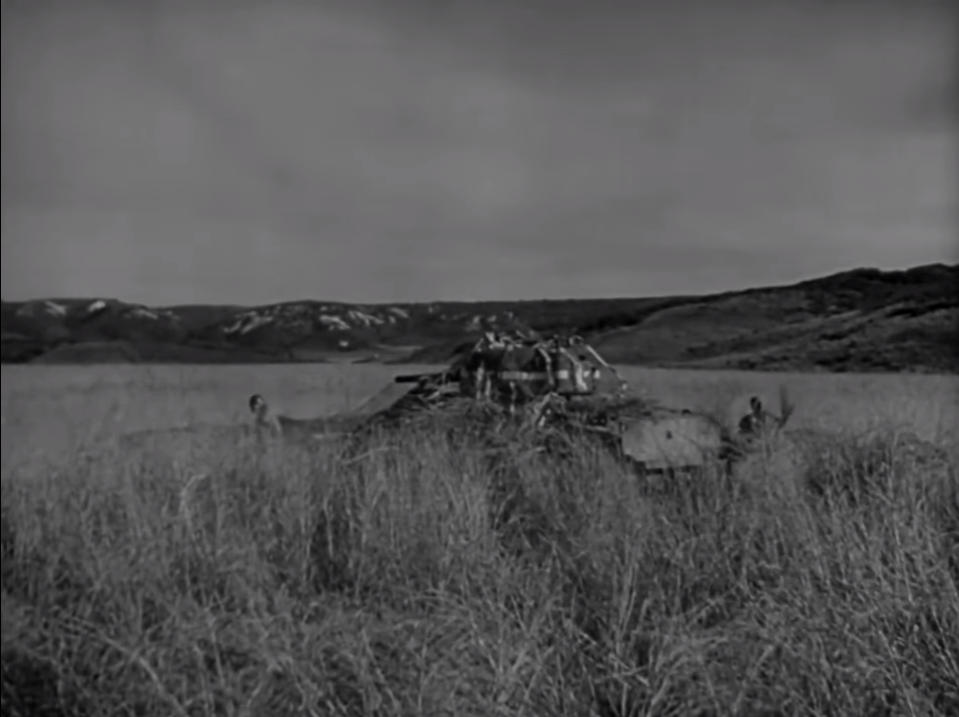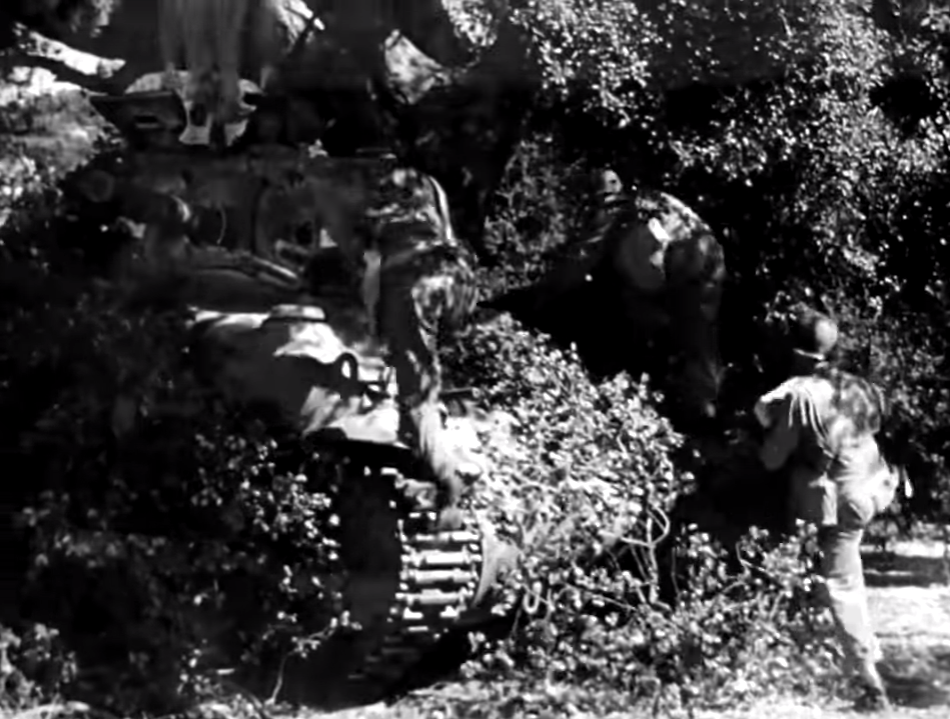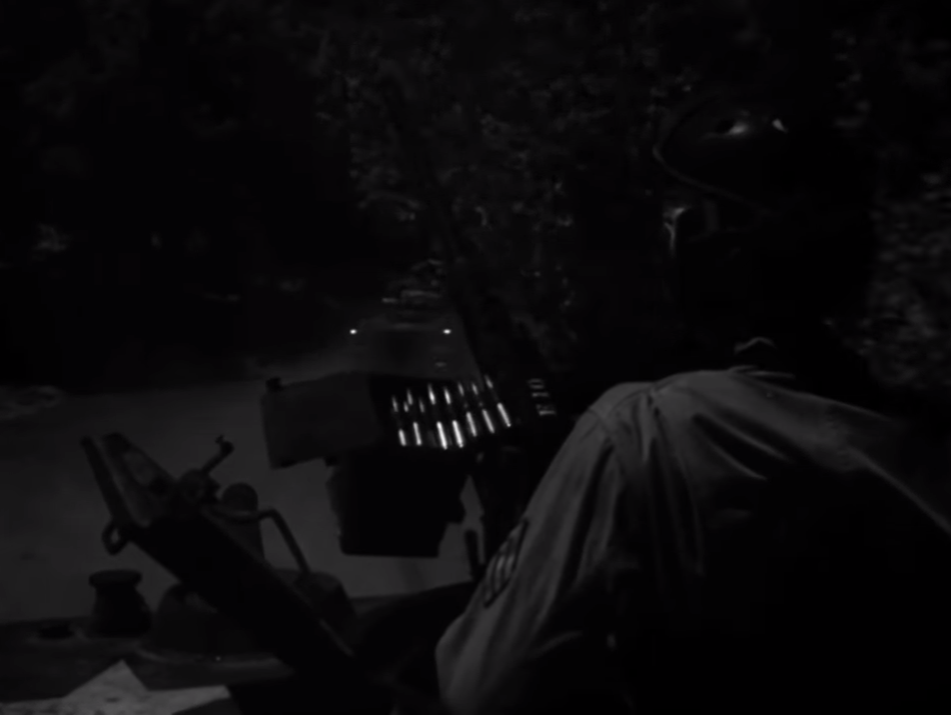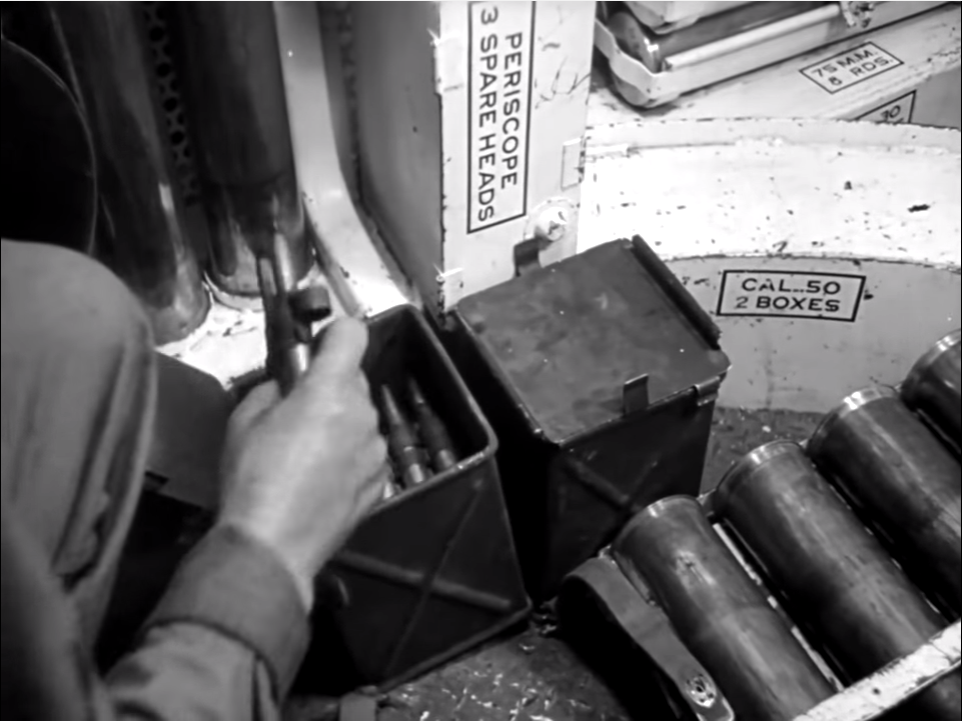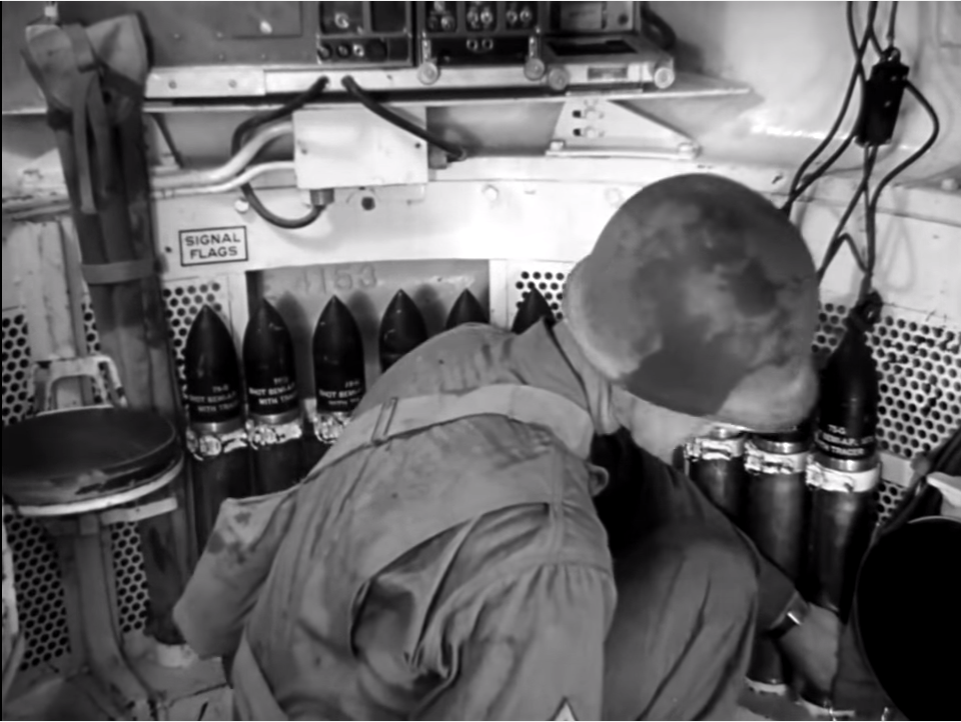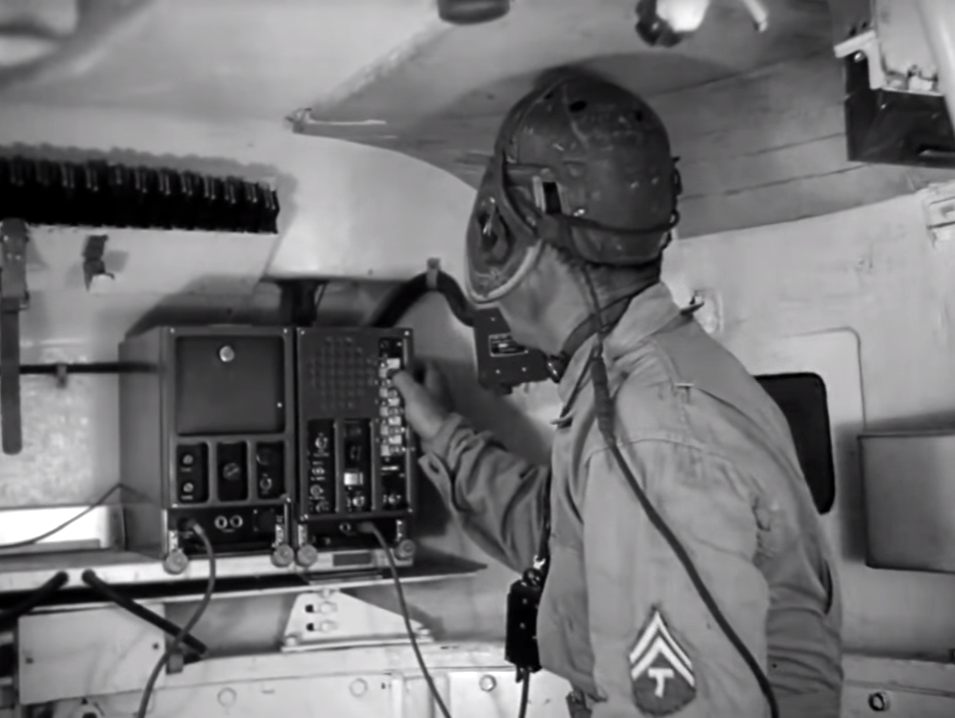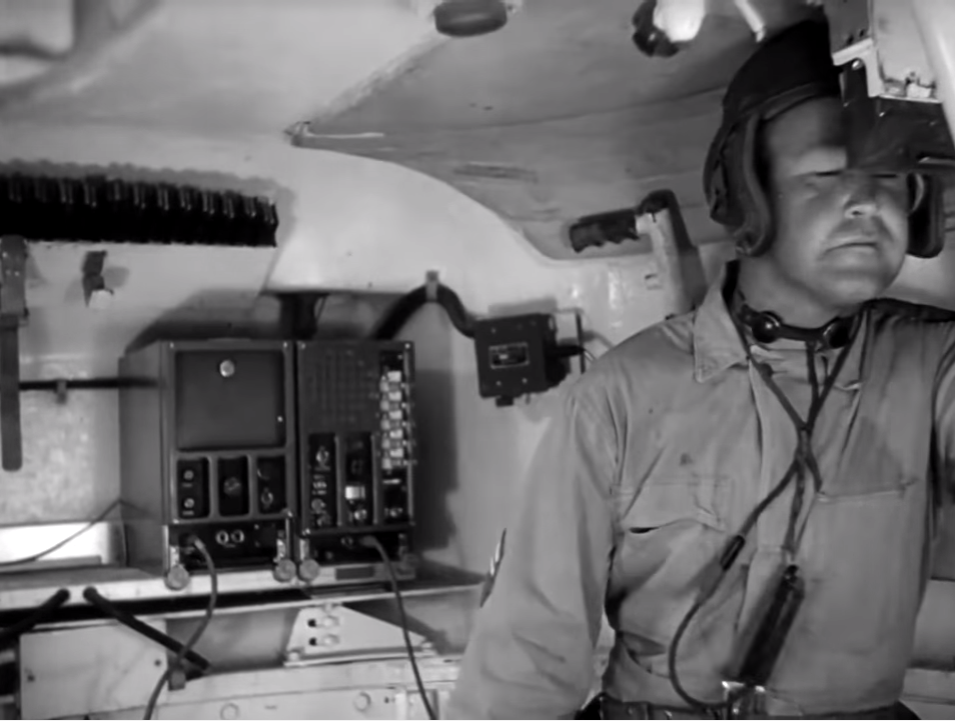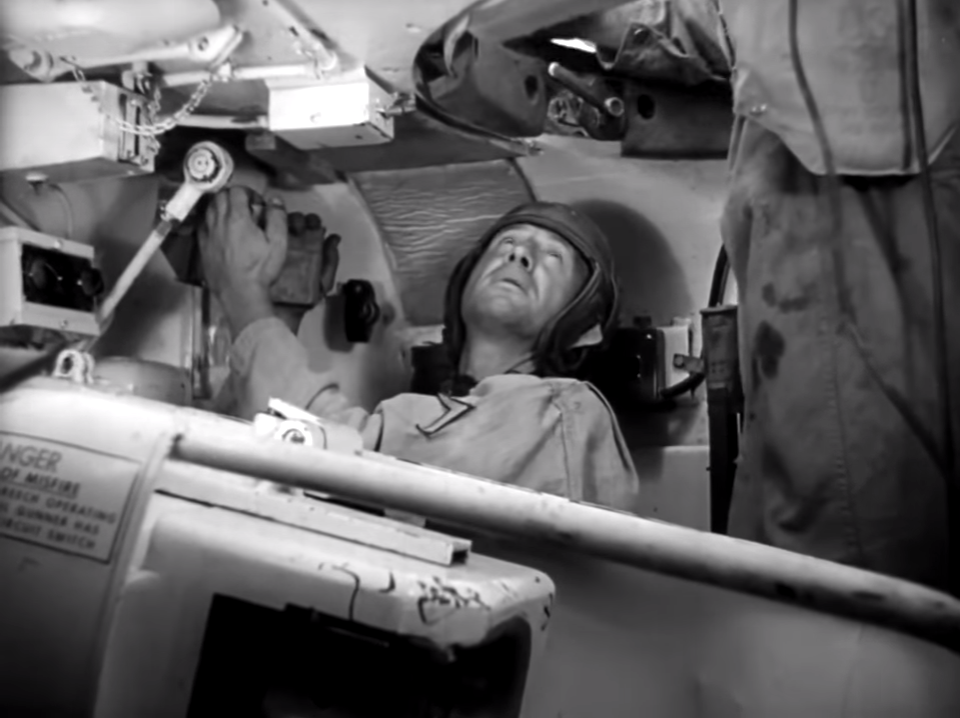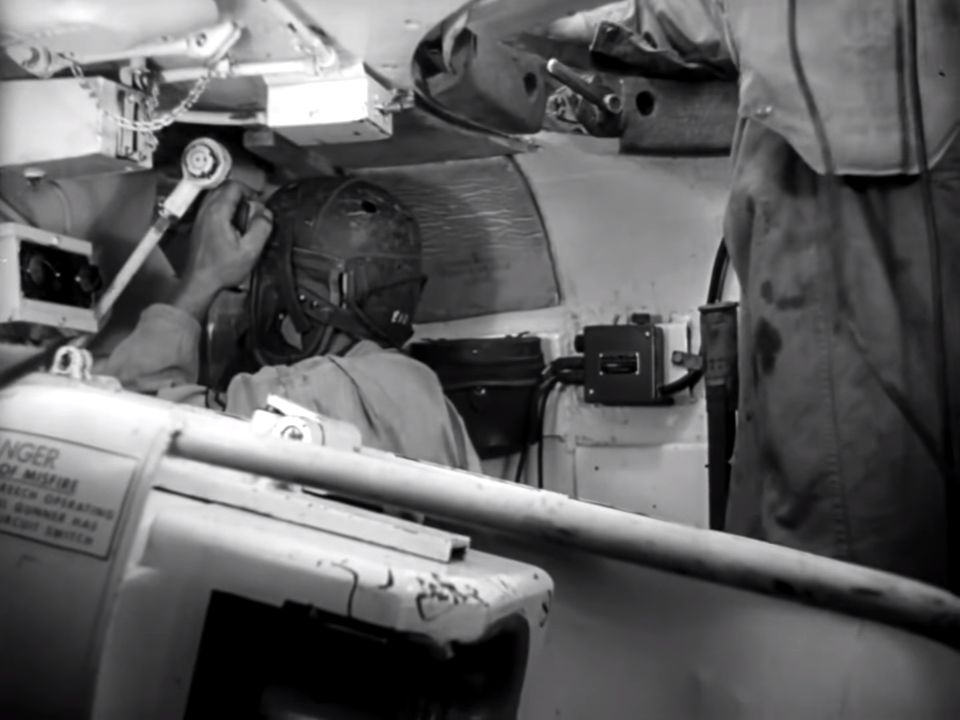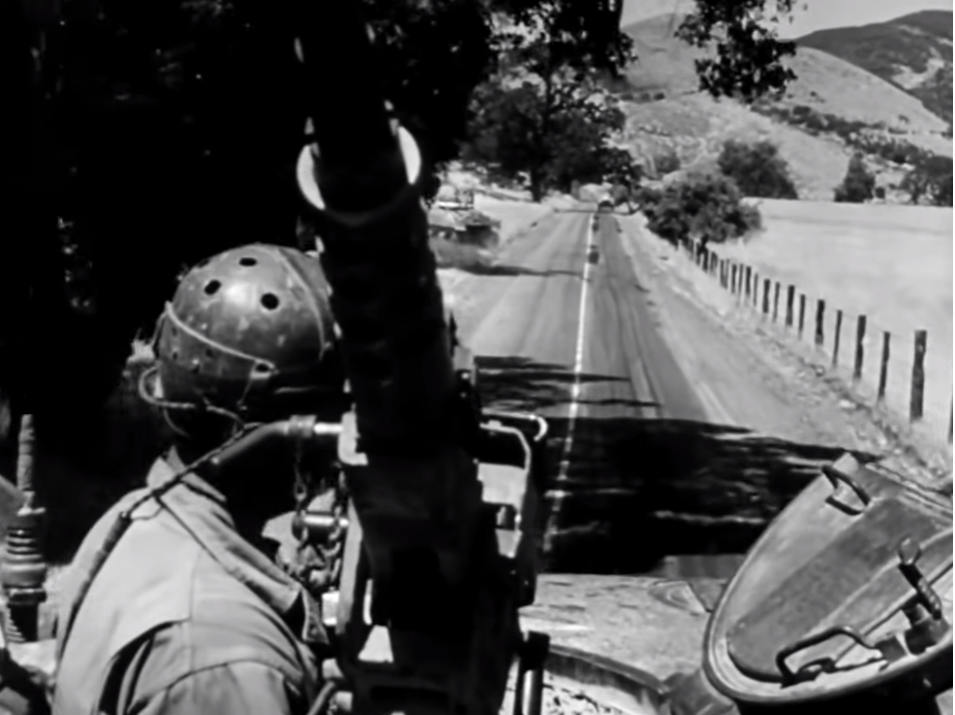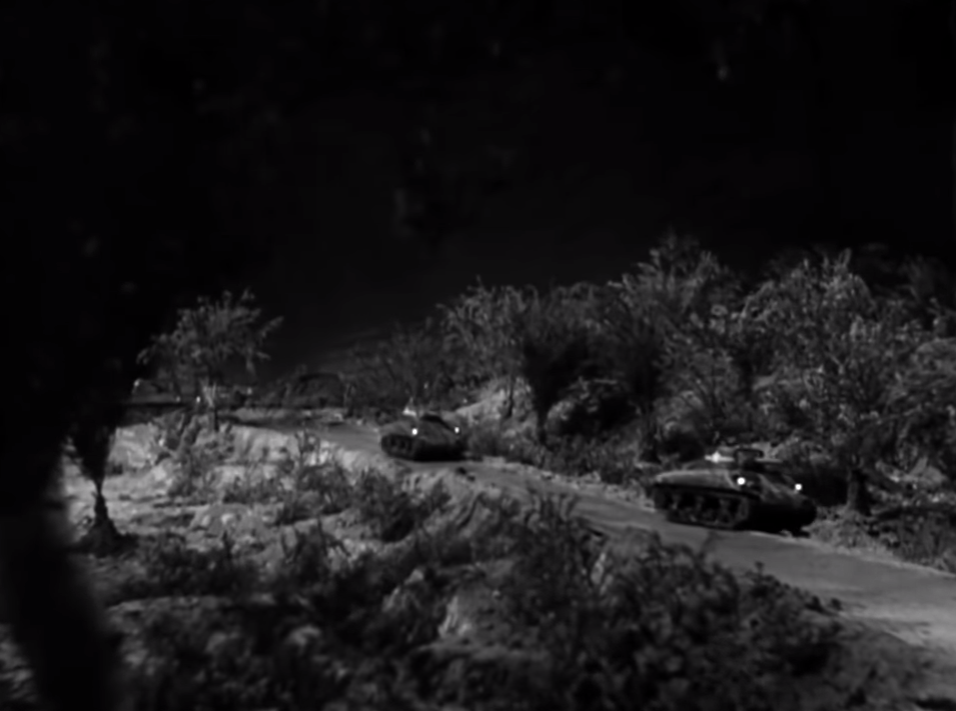Security on the March: With the Sherman Tank
Tank and AFV News posted a link to a fascinating YouTube video covering march security of mechanized units, the film is from early 43. This Army training film is almost a half an hour long, and it’s really interesting, and has some rare shots of men working inside a Sherman. The film takes place somewhere in the US, probably on a Hollywood backlot, the Desert Training Center was pretty close so getting the tanks to Hollywood wouldn’t be hard. At times the film is clearly using special effects, and that lends more credence to it being done in Hollywood. The film covers security on the march, and does it by covering a tank platoon, and what it should be doing. It covers night movement, camouflage when stopped and gives tips on being stealthier in your tank; it also covers how to use the columns firepower if attacked from the air.
The tanks used were all early M4A1s, but not super early since they are not DV tanks, but still have shorty gun mantlet and no telescopic sites, they do have heavy duty suspension as well. The tanks also have full turret baskets, with the 12 unprotected ready rounds, and no armor over the sponson ammo racks or the turret cheek add-on armor. Its possible training tanks did not have these features removed like tanks slated to see combat, or the film was made very early in the war.
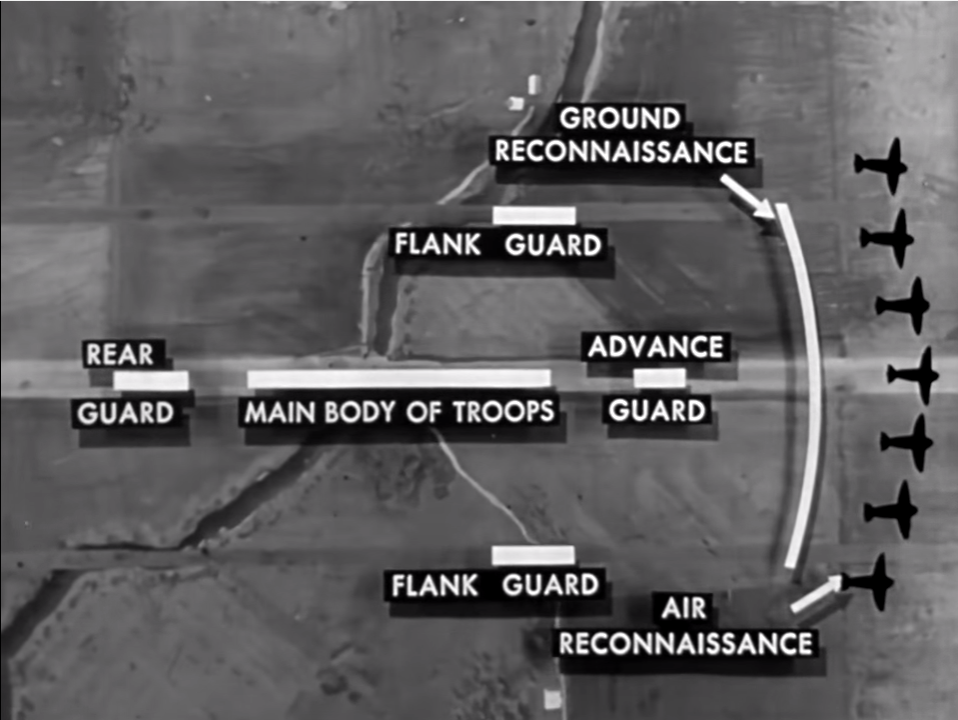
It is an Official War Department Training film, number T.F. 21 2035, and I want to make sure and thank Jeff Quitney for putting it up on YouTube! I had never seen it before so it was a real treat. He has a lot of other good content up on YouTube as well so check it out.
Now let’s talk about the contents of the Training Film.
Right off the video starts off with a M4A1 driving by on a dirt road, it’s going at a good clip, and you can just make out another M4A1 trailing behind it at a few angles. The next shot shows a tank crew in front of their M4A1 going over a map with commander, and it just keeps getting better. I took well over 100 screen caps watching this film.
The training film makes it clear there are the five things that need to be kept in mind at all times to make a road march safe.
- Advanced prep
- Alertness
- Concealment
- Dispersion
- Firepower
The enemy’s goal in an ambush would be to get to the main body of the column, and the film talks about how they should move, and covers things down to where each vehicle is to point its gun, to be prepared for an attack that might come either from the air, or ground. The film focuses on the actions of a single, five tank, platoon in the main body of the column, and then covers each of the five steps previously mentioned, and how that platoon would do them.
-
Advanced Preparation: Because good prep makes for smooth operations.
- Be ready for gas, liquid vesicant detector paint, this pain, turns green to red when vesicant gas droplets touch it. A large square of this stuff was painted on the front of the tank. Then the decontaminator stored in the tank could be used to spray down the tank. The crew was also issued gas masks, and this was the time to make sure they were in working order.
- Check the tanks readiness out. The Commander needs to check the tanks fuel level personally. The Crew, checks the engine out, checks the tracks, and checks out the ammo load. Do not leave with an empty ammo rack if ammo is available. Main gun rounds should be clean and undented.
- Platoon leader review whole route on the map with all tank commanders. Cover all points of interest along the route, likely ambush spots, landmarks, areas of good cover for rest points etc. Each tank commander will then pass all this info along to all his crew members, ensuring they can all fill in for each other. If one tank has to fall out for any reason, its crew knows the whole route and plan.
-
Alertness: Because surprise is the enemy’s best weapon, always be on guard for attack, air or ground.
- Every man in each tank turret is an air observer, the Tank Commander should always be looking around the tank, scanning the ground and air, and looking back. The Co-Driver should be watching the flanks, because the Driver is watching the road. The gunner and loader should be using their periscopes, all scanning for an attack.
- The crewmember in the turret hatch needs to be alert, so when the commander is tired and needs to take a break, the gunner or loader will swap places with him. The Commanders position, no matter who is manning it has to be ready to receive signals from the platoon or company commander and pass them on, be they flag, or hand or radio. He also has to be able to see a messenger that needs his attention. The Loader should help the commander tend the radio, and the crew should listen to the radio to keep informed.
-
Concealment: Keeping a 32 ton tank as hidden as possible!
- Dust is bad. You can’t hide tanks in a dust cloud, so don’t drive on soft dusty shoulders if you’re on a road. Even if that shoulder is shady, and will make the tank more pleasant inside, the dust can be seen for miles. Sometimes it can’t be avoided, but try to do so as much as possible. Line formation is best for use in places dust cannot be avoided. Driving at a slower speed can help minimize dust as well.
- Shielding Terrain is to be taken advantage of anytime it won’t produce large amounts of dust.
- Shade is ok is it does not make extra dust, and can help hide you from air observation.
- Your goggles can reflect light for miles; if you’re not wearing your goggles store them in the tank. If they are needed to protect your eyes, they should be covering them. This applies to any shiny object.
- Do no silhouette your tank on a hill or high ground. Drive around the base of the hill. If you have to drive on a hill stay below the crest.
-
Dispersion: Bunching up is bad, if you are to close one artillery round, or bomb can damage multiple vehicles.
- Bunching up like a bunch of cows with their tails in the breeze is bad. This makes you a big target.
- Proper daylight spacing is at least 75 yards between tanks. If visibility and terrain allow, you can have more than 75 yards, but never less. In hilly terrain it is easy to bunch up, keep your eyes on the tank in front of you if it starts slowing down; you will have to as well.
- Falling Out. If your vehicle has to fall out for some reason, engine troubles, or some other issue, make sure you pull far enough off the path to not cause a bottleneck on the path, and slow the rest of the column. Make sure and signal the column and platoon so they know what is going on. Don’t try and catch up, wait for a halt, then retake your position. Fall in with the rear guard until the halt.
-
Firepower: A Sherman tank packs a lot of punch, keep it ready, it’s your ace in the hole
- The main gun should be trained out and ready, but not loaded. The lead tank and the next in line keep their main guns aimed straight ahead. The third tank in line keeps its gun trained out to the right. The fourth tank keeps its gun trained out to the left. The fifth tank will have its main gun traversed to the rear.
- M2 .50 anti-aircraft guns should be kept half loaded, so they can be quickly brought to bear on any attacking aircraft. To keep the column covered, alternating tank commanders look forward and to the rear during air attack.
- Do not halt, during an air attack. Your tank is much harder to hit when moving. Even if you have good concealment, do not stop. When a plane is sighted signal the rest of the column, close all hatches but the commanders, alternate the .50 AA guns and engage the aircraft.
- Report the results of any air attack up the chain of command. TCs report to Platoon Leaders, Platoon Leaders to Company Commanders, etc.
Halt security: Units on the move have to stop, for human reasons or mechanical ones, and you can’t just do it willy-nilly, there’s a plan for that too.
There are two kinds of stops a unit on the march will make. The short ten minute halt, to check the tanks out, for the crews to stretch their legs, no major maintenance will be taken on these short halts. The second kind is the Long halt. On the long halt, the tanks can be repaired if anything major popped up and refueled, and the crews could get some chow.
Security rules and things to note on the short halt:
- Check the ground where the tank will be parked, make sure the tank won’t get stuck, or sink in. Back into the spot so you will not have to back out if the tank needs to move out in a hurry.
- First Echelon Tank Maintenance should be done on the short halt, check the tracks, tighten the end connectors, check the motor out, lube as needed.
- Review the course, check out the route the column is taking on the map, and review it with your crew and the rest of the platoon.
- Be Alert, post guards, at least two from each crew. One man must always be on the platoon leader’s radio. Do not let the enemy sneak up on your position.
- Disperse on the halt, in the same pattern as on the move; each tank is still responsible for covering the area they were covering with their main gun. Use any cover available on the halt to conceal the tanks as best possible from air or ground observation. Spacing cannot be less than 75 yards.
- Each tank will have the commanders .50 manned.
- When pulling out, each tank will keeps its spacing, and will not stop on the road to form up.
Security Rules and things to note on the long halt:
- All the rules for a short halt apply
- You can pull further from the road on a longer halt. A guard has to be posted near the road to receive any signals though.
- Dig Prone Shelters, you might not be able to get back into the tank in a surprise air raid or artillery attack.
- Eat while you work, you never know how long the halt will be.
- Take more time to conceal the tanks, cut or break off tree branches and use them to break up the tanks lines. Rake the tanks tracks leaving the road away.
- Use shade and any local cover to hide the tank, move the tank as the shadows used to hide them move with the sun.
- If no cover can be found, use the camo net.
- Some camo is better than nothing.
Special Rules for night marches:
- If under air attack, Stop, for both concealment, and to prevent bunching up.
- If under air Attack, Do not fire, unless you are sure you are spotted.
- If under air Attack, Turn off your marker lights, the video doesn’t say this, and they used models in the film, but I think it’s a safe assumption.
- No light, not even a smoke, and smoking is bad anyway, mmmkay.
…
Now for some thoughts on the film, it is really very interesting for several reasons, and the quality is very good. The main reason it’s interesting is the look at prewar combat, or pre air superiority march doctrine. The attention paid to defense from air attack would not be pushed nearly as much even by the Italian campaign and would be almost an afterthought by Normandy. Later films probably pushed very carefully searching for well concealed AT guns and infantry that the lead and flank scouts may have missed.
It is also interesting how gas attacks and preparation for them is first thing they cover. I’m sure shortly after most unit got in combat they ended up losing or discarding most gas related gear, and I can’t ever recall seeing a man carrying a gas mask case or a square of the gas detecting paint on any vehicles in combat photos.
The night shot of tanks moving is clearly done with models. The machine guns used during the mock air raid also appear to be prop guns. If you watch carefully, most of the film, the .50 M2s have the normal short cooling sleeve with round holes, during the shooting scene, these have slotted sleeves, and the barrels do not seem to recoil at all. The explosions look like typical Hollywood fare as well. It should come as no surprise Hollywood was willing to help the war effort; this is just one example of many. All the big studies did propaganda movies and even Bugs bunny and Disney got into the act.
I have been looking the tanks over, they are all M4A1 75 tanks, they are all small hatch hulls, but none are DV, they all have heavy duty suspension bogies. Two have three piece cast differential housings, the rest have the first version of the cast one piece diff housing. The turrets all look the same for the most part, with the short mantlet, so M34 gun mounts with no telescopic sights. Some of the gun mounts have slanted lift rings, others don’t seem too. At least one turret has the port for the spotlight on the roof. One tank has the siren mounted in the front plate with the odd single brush guard, the rest seem to have them mounted on the fenders. Two or three of the tanks appear to have T54 steel chevron tracks, while two or three seem to have T47 steel bar cleat tracks. I’m bad at spotting the little clues that give away who made what, but I think two of the tanks were made at PCF in Washington; I think the two tanks with three piece diffs are from PSC in Illinois.
